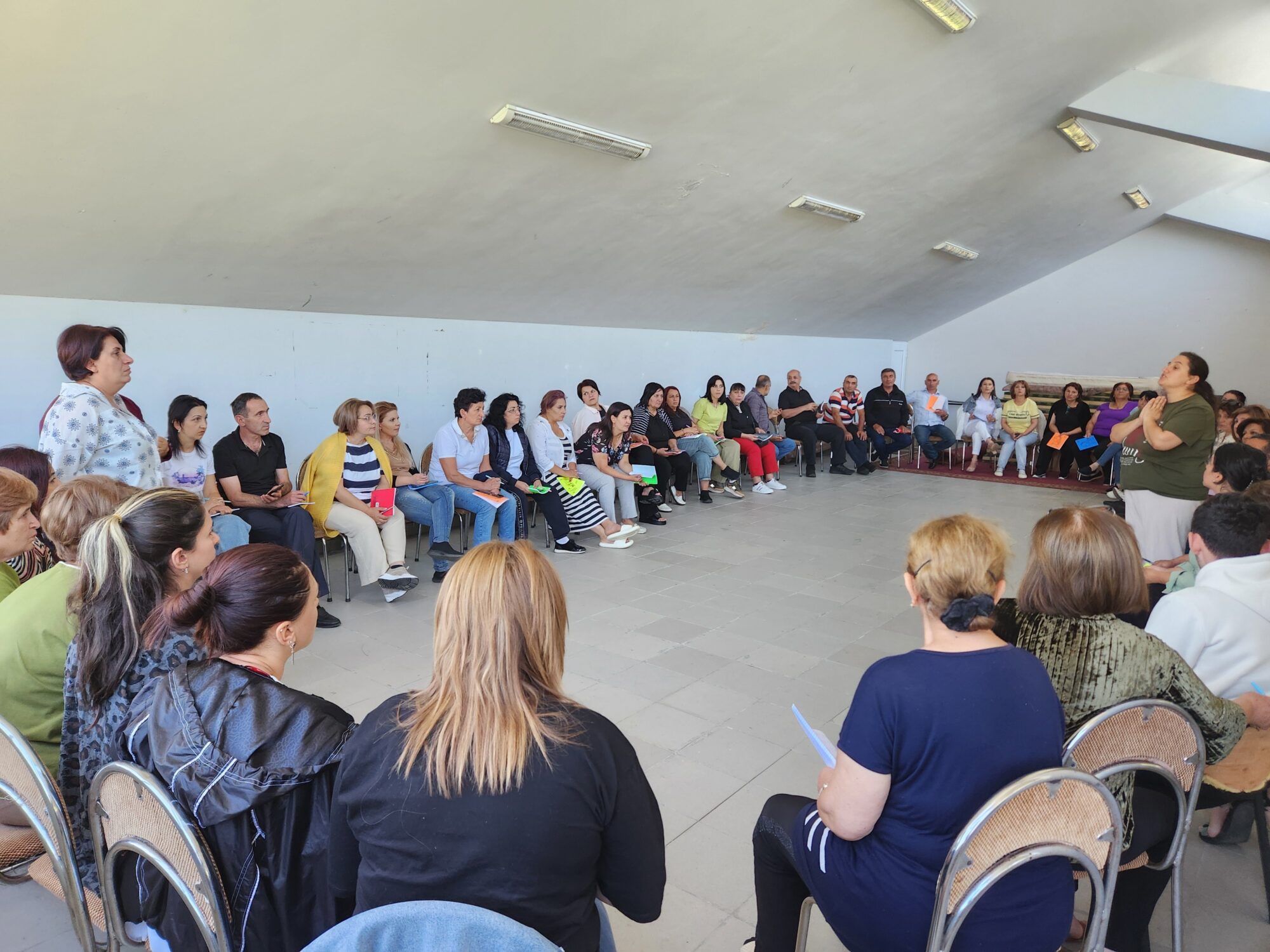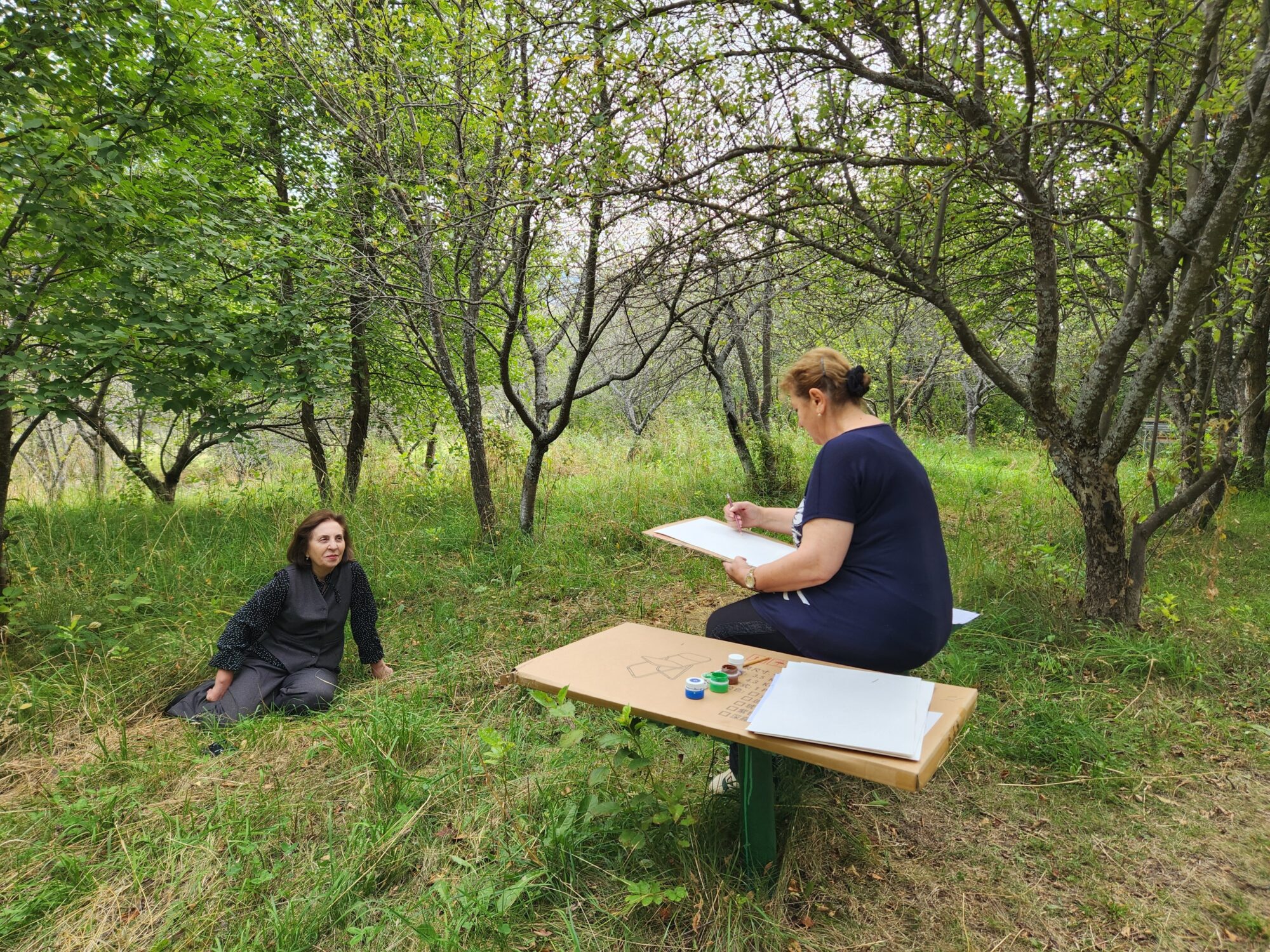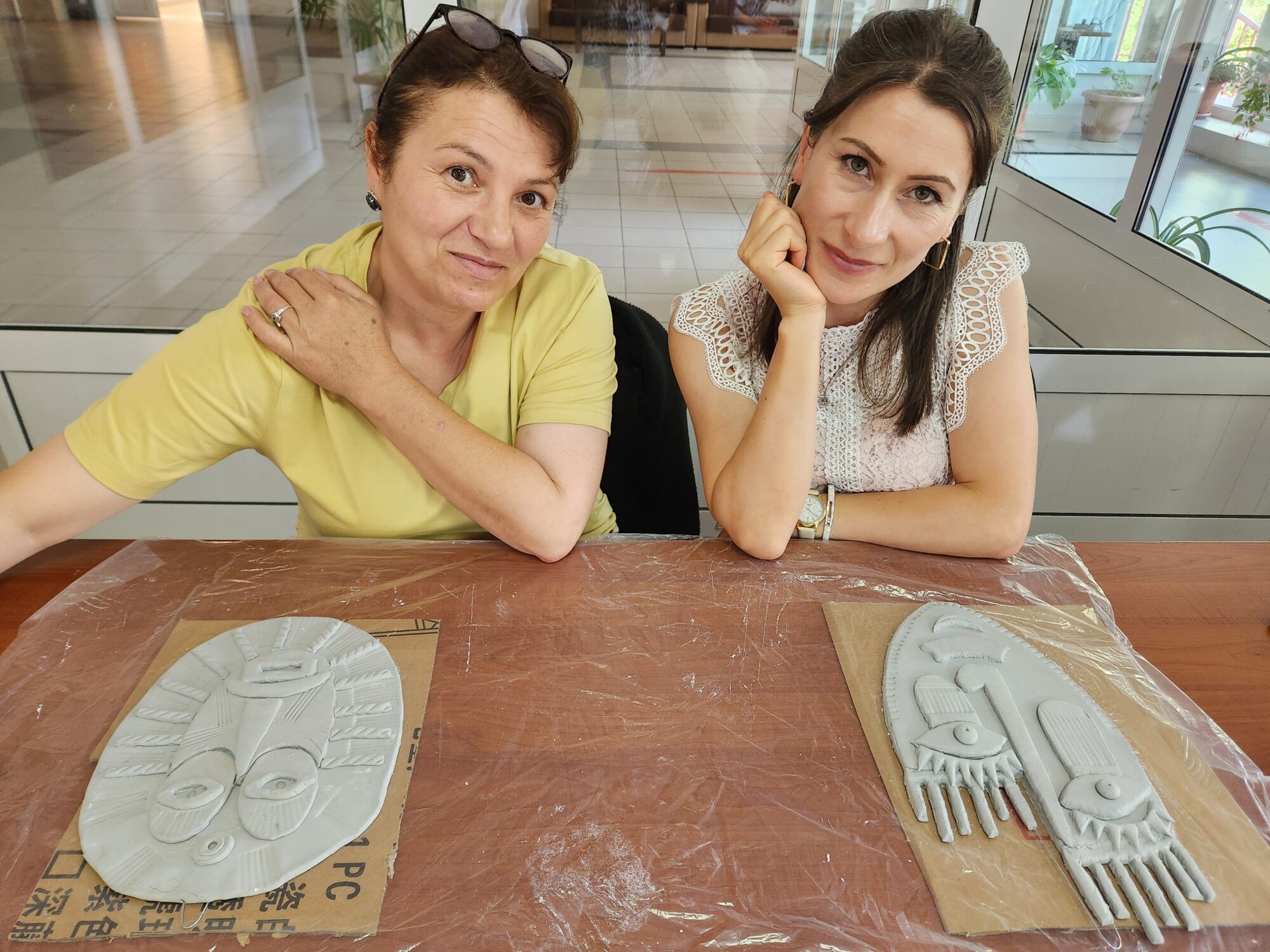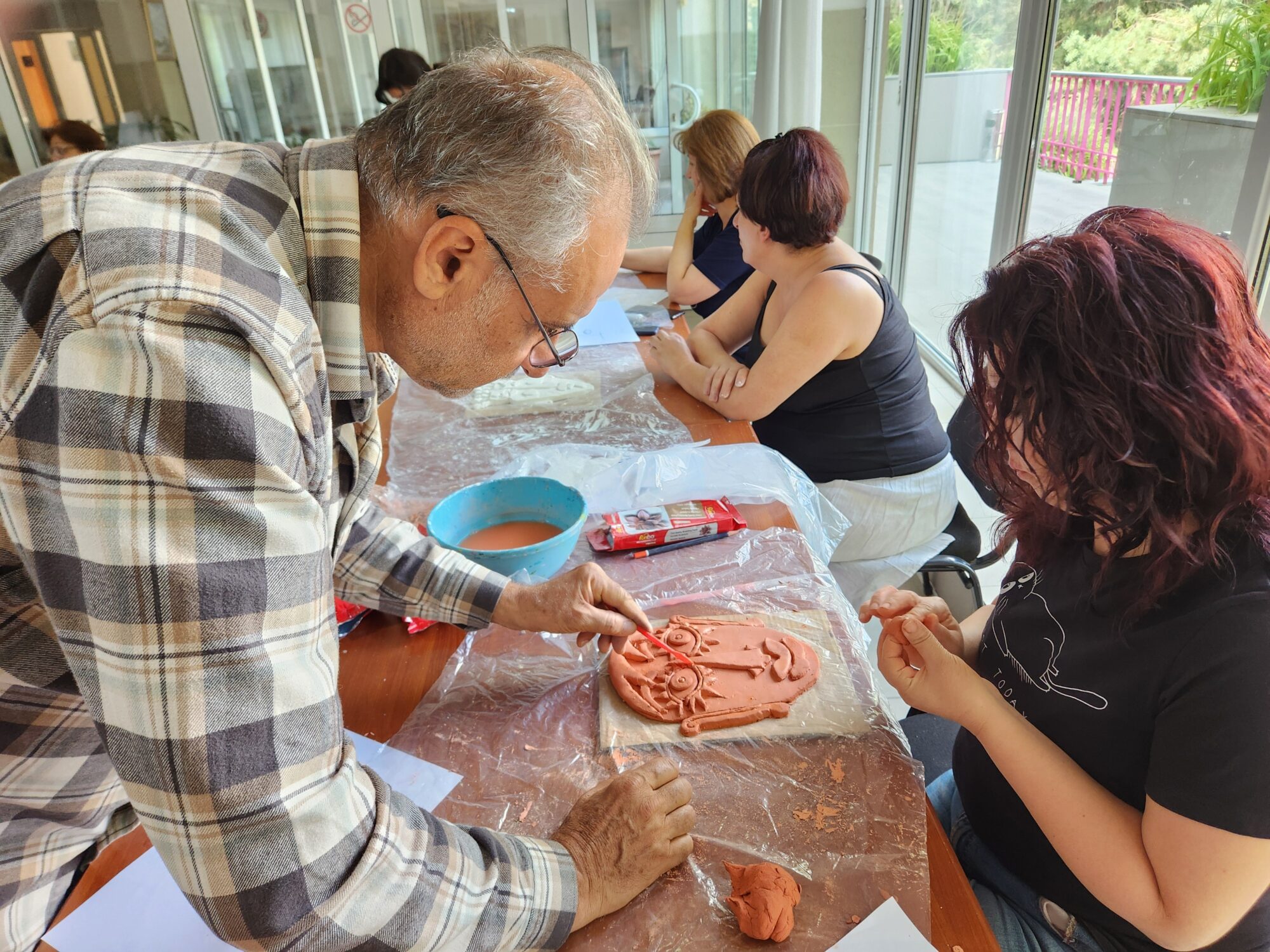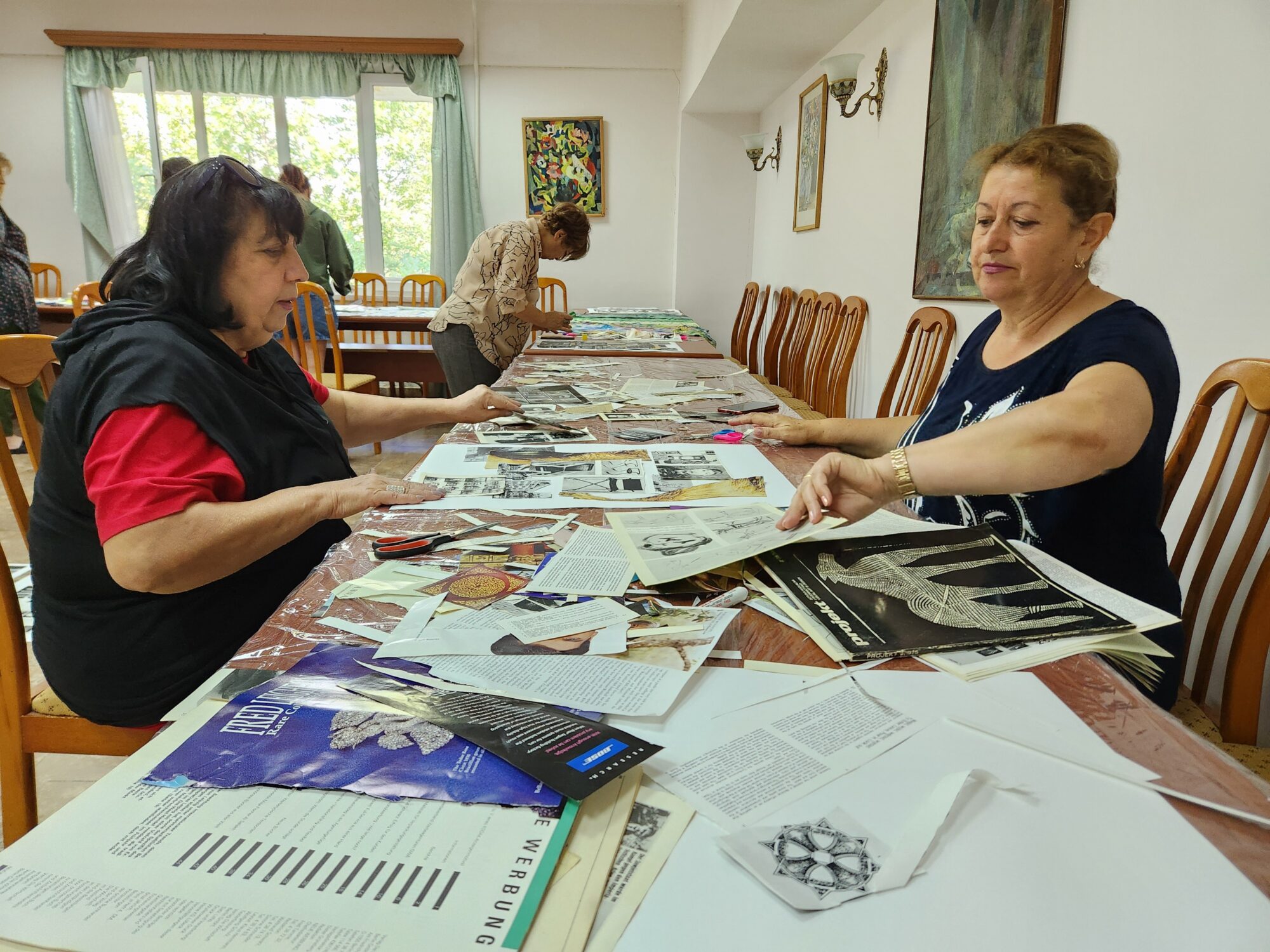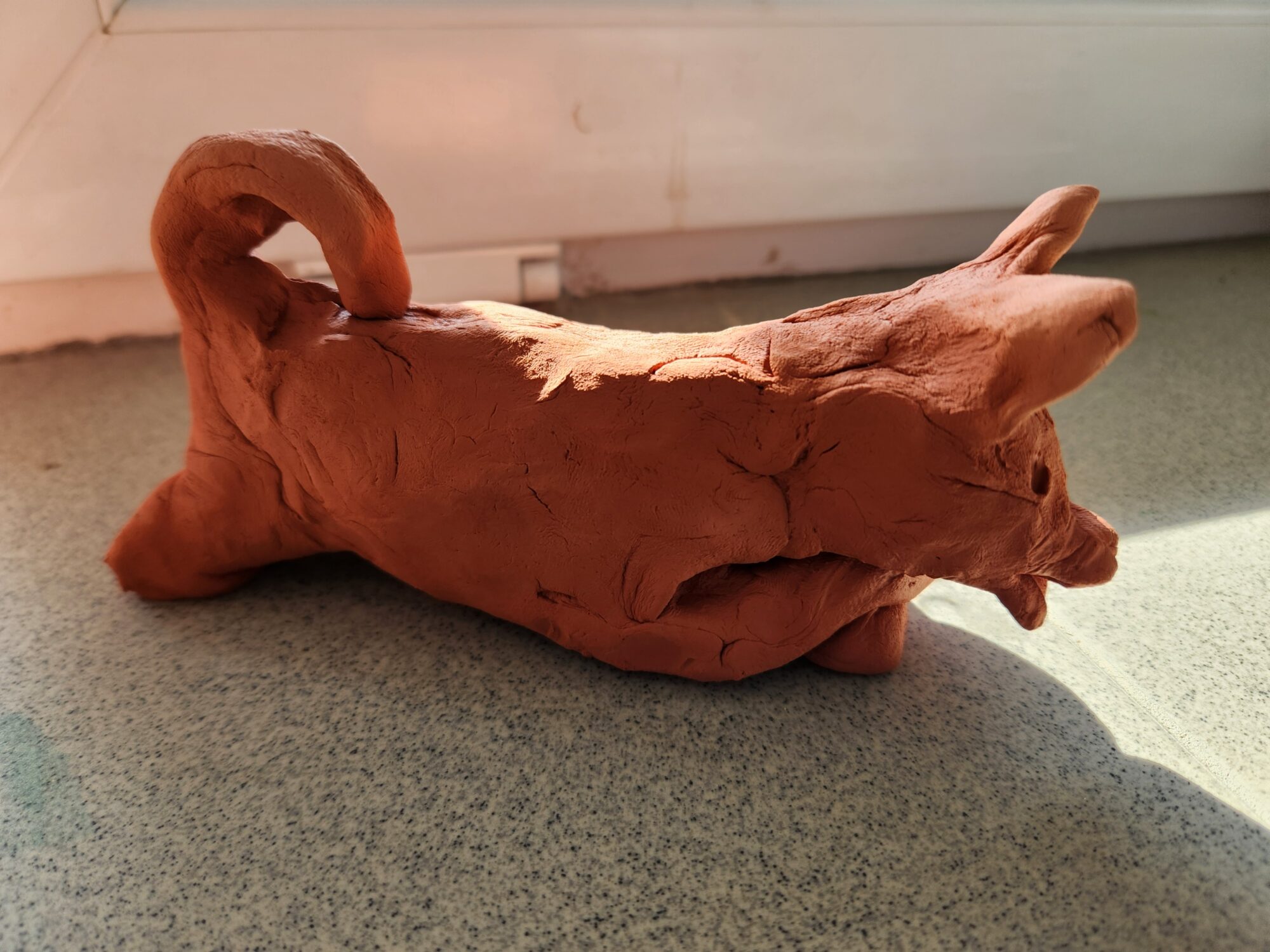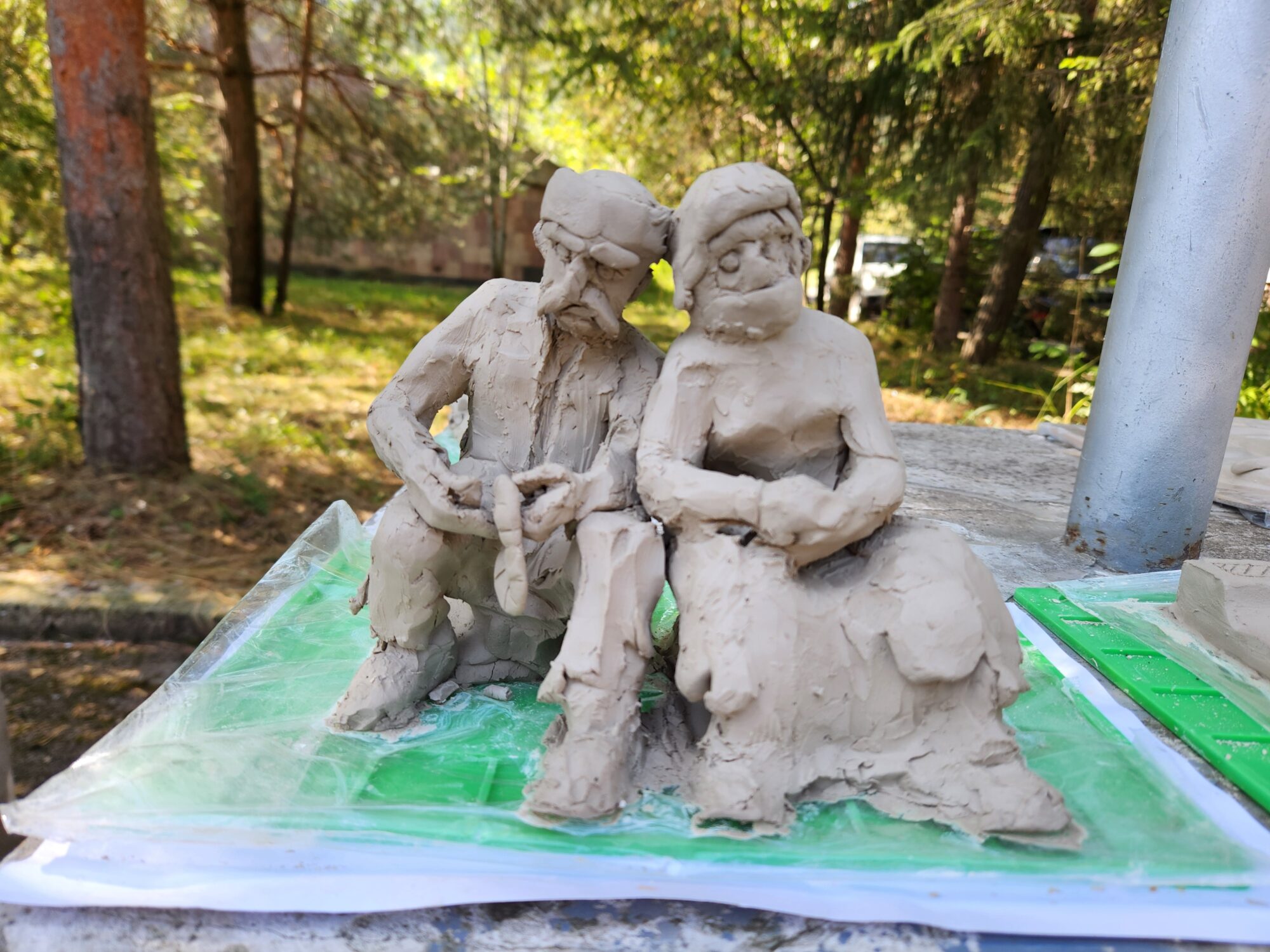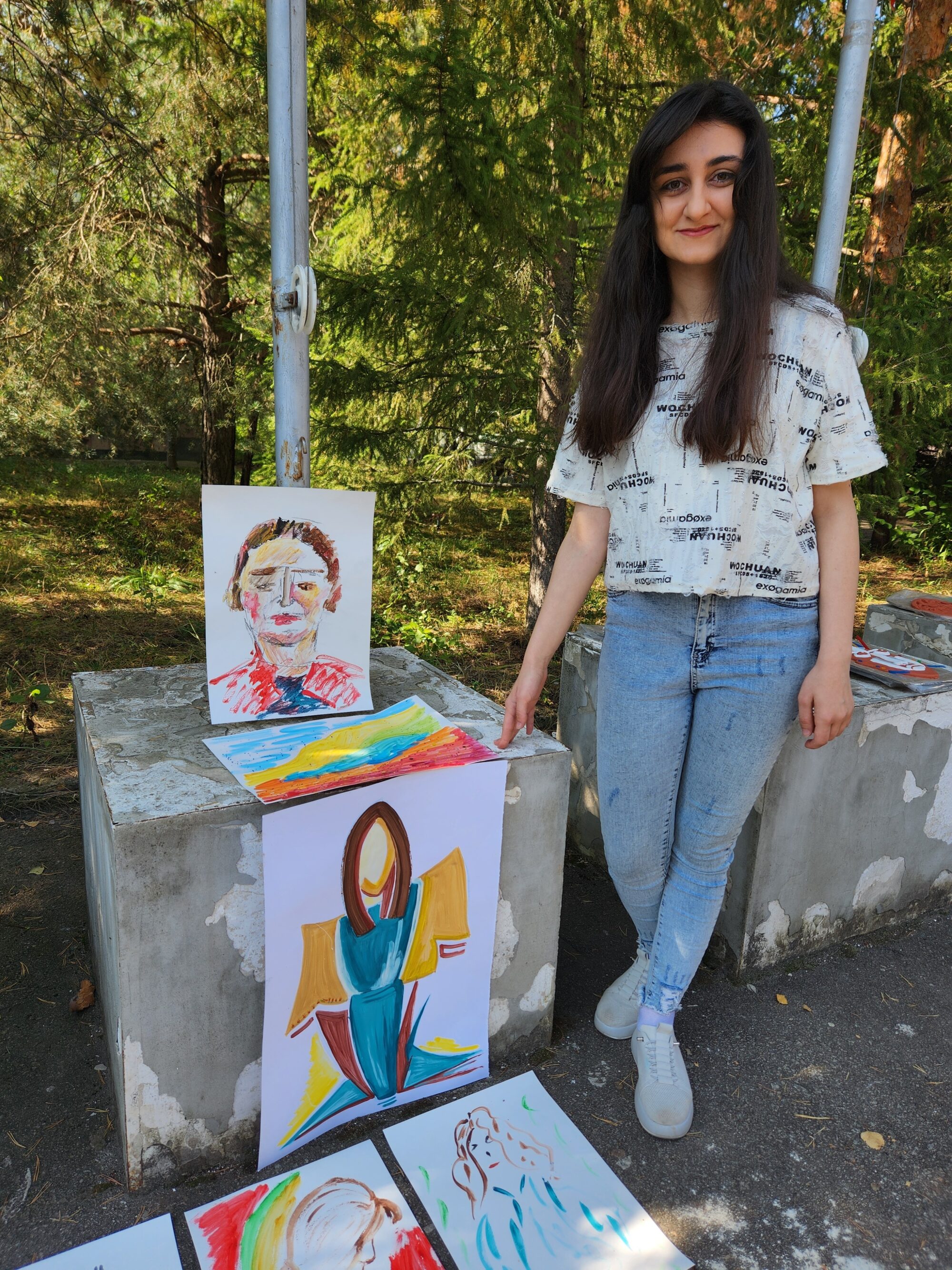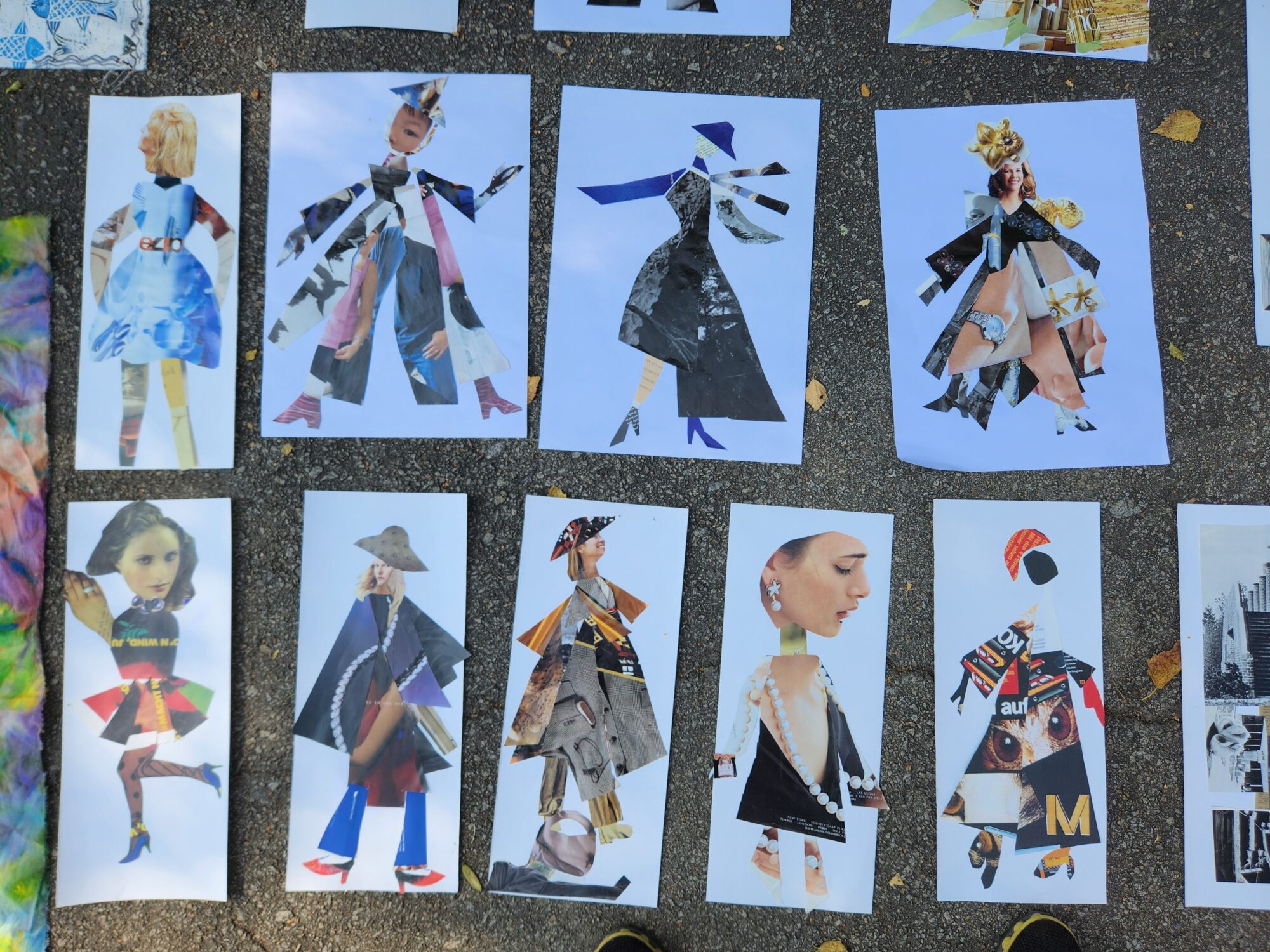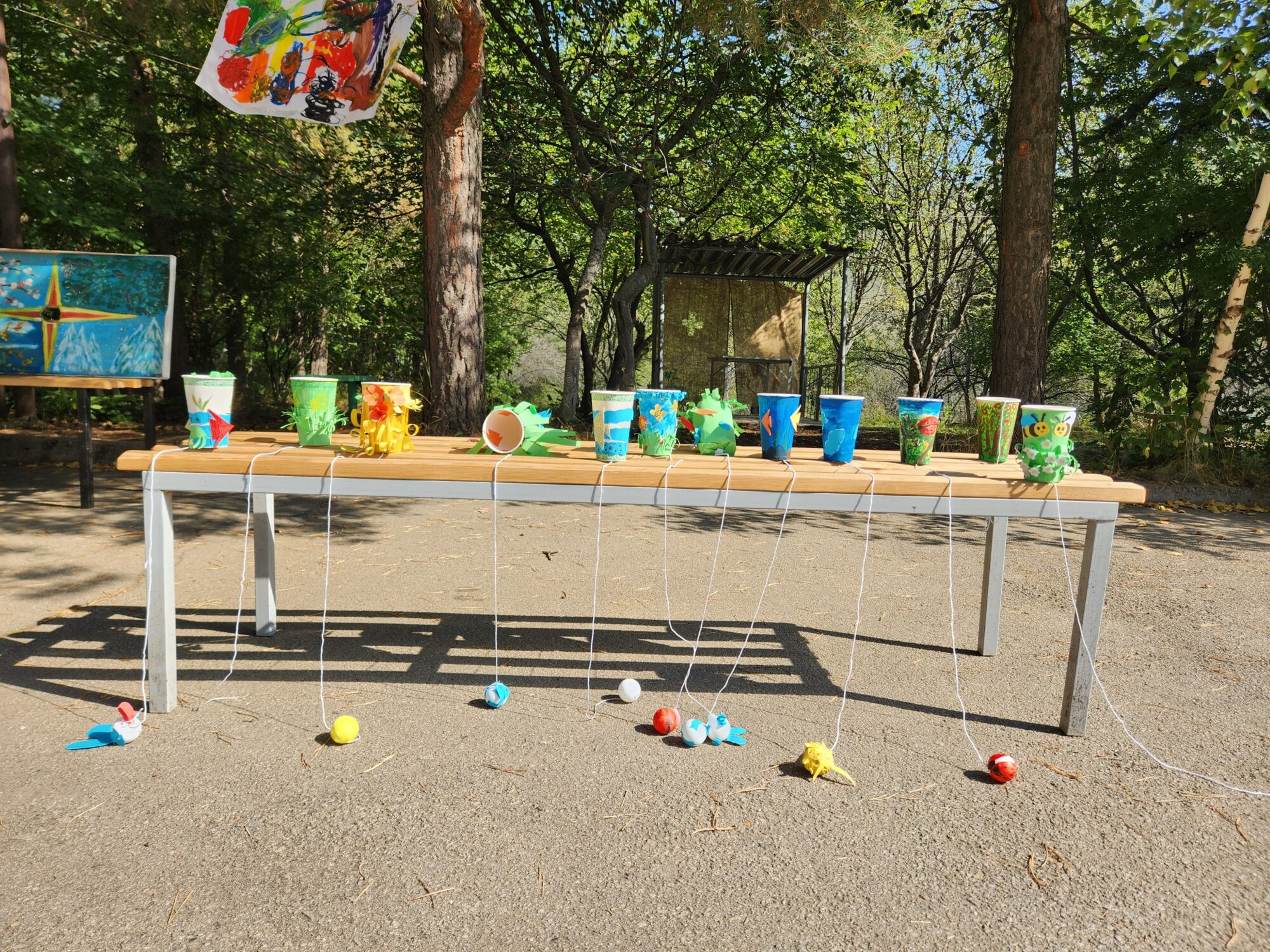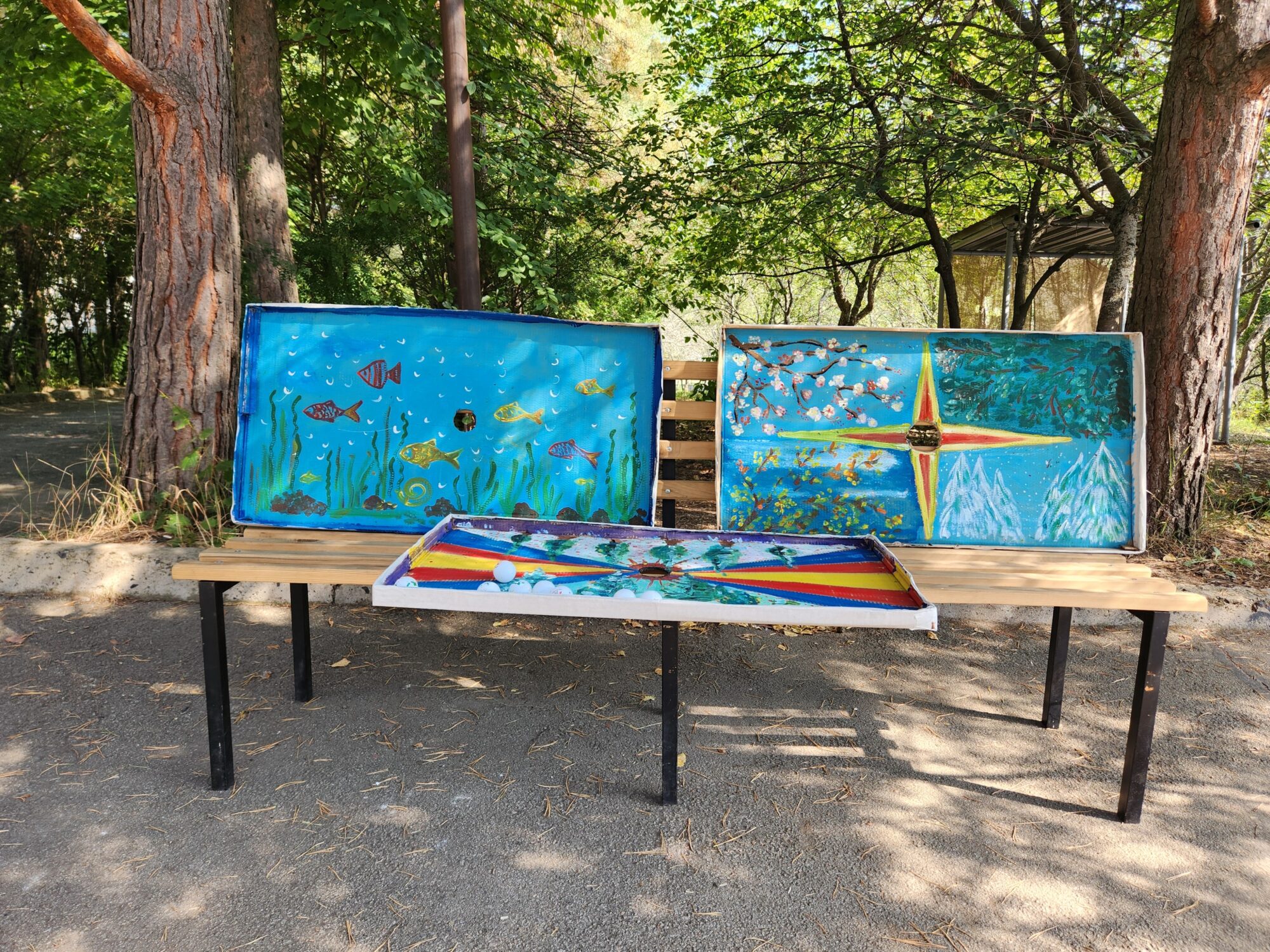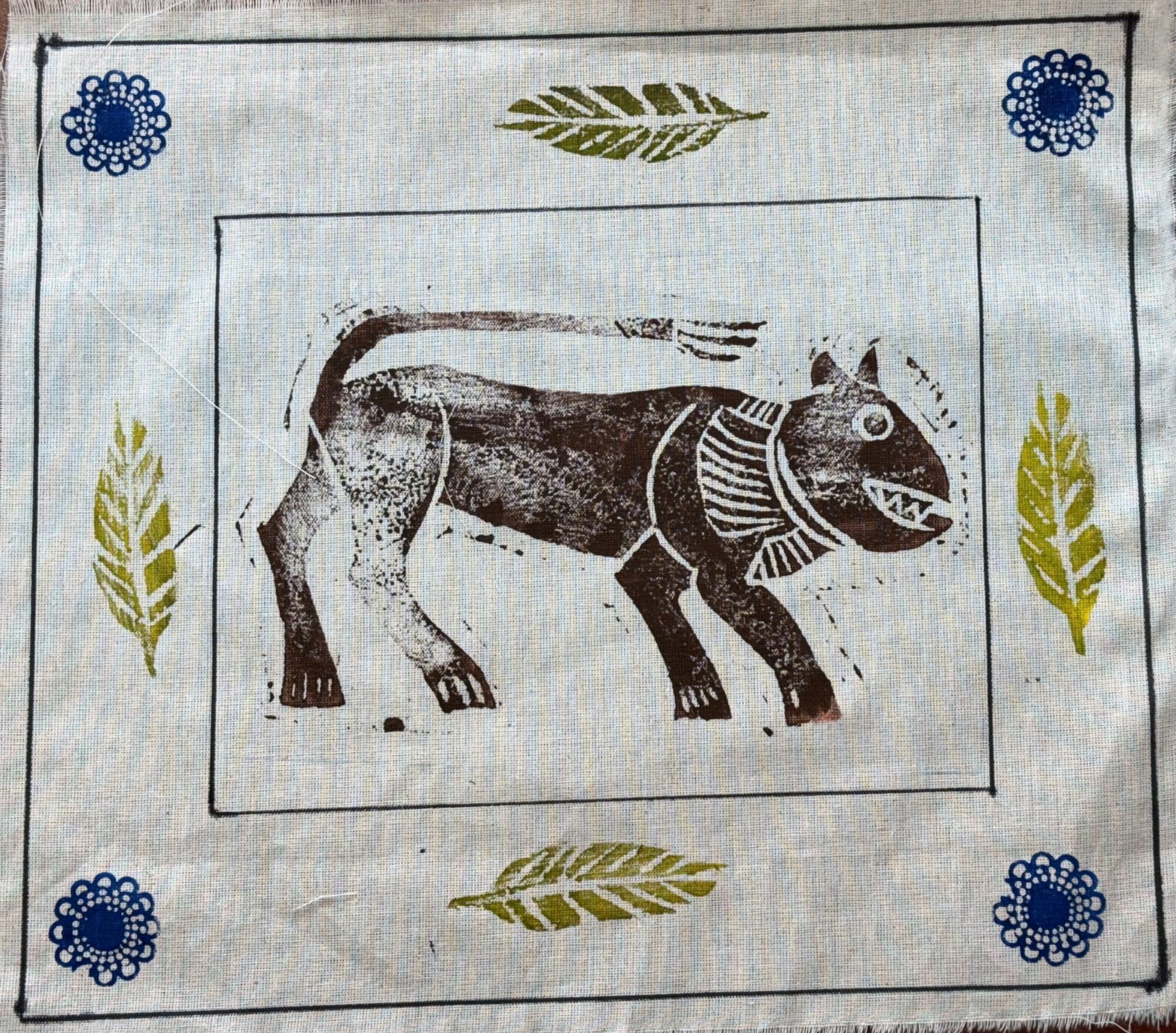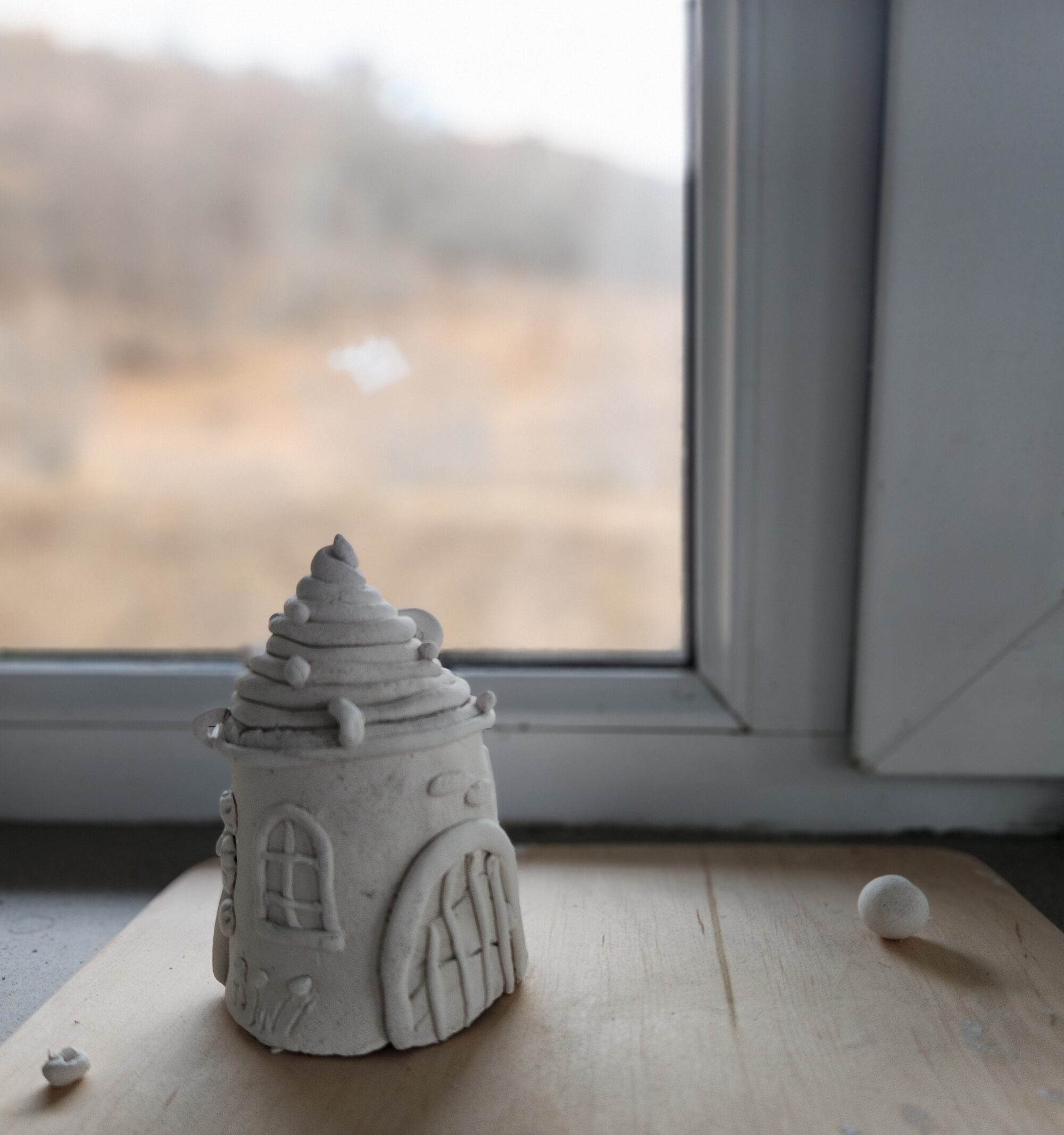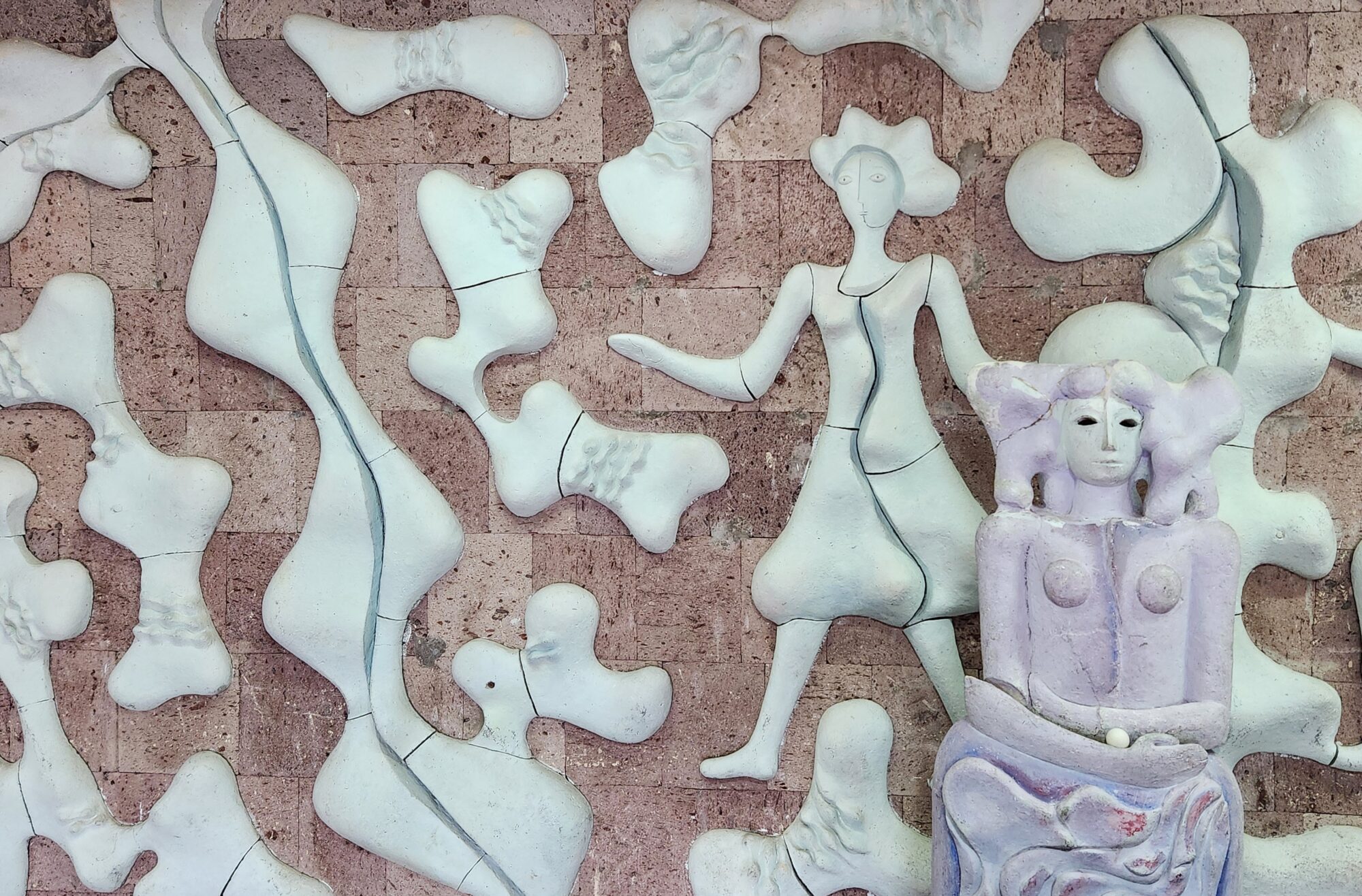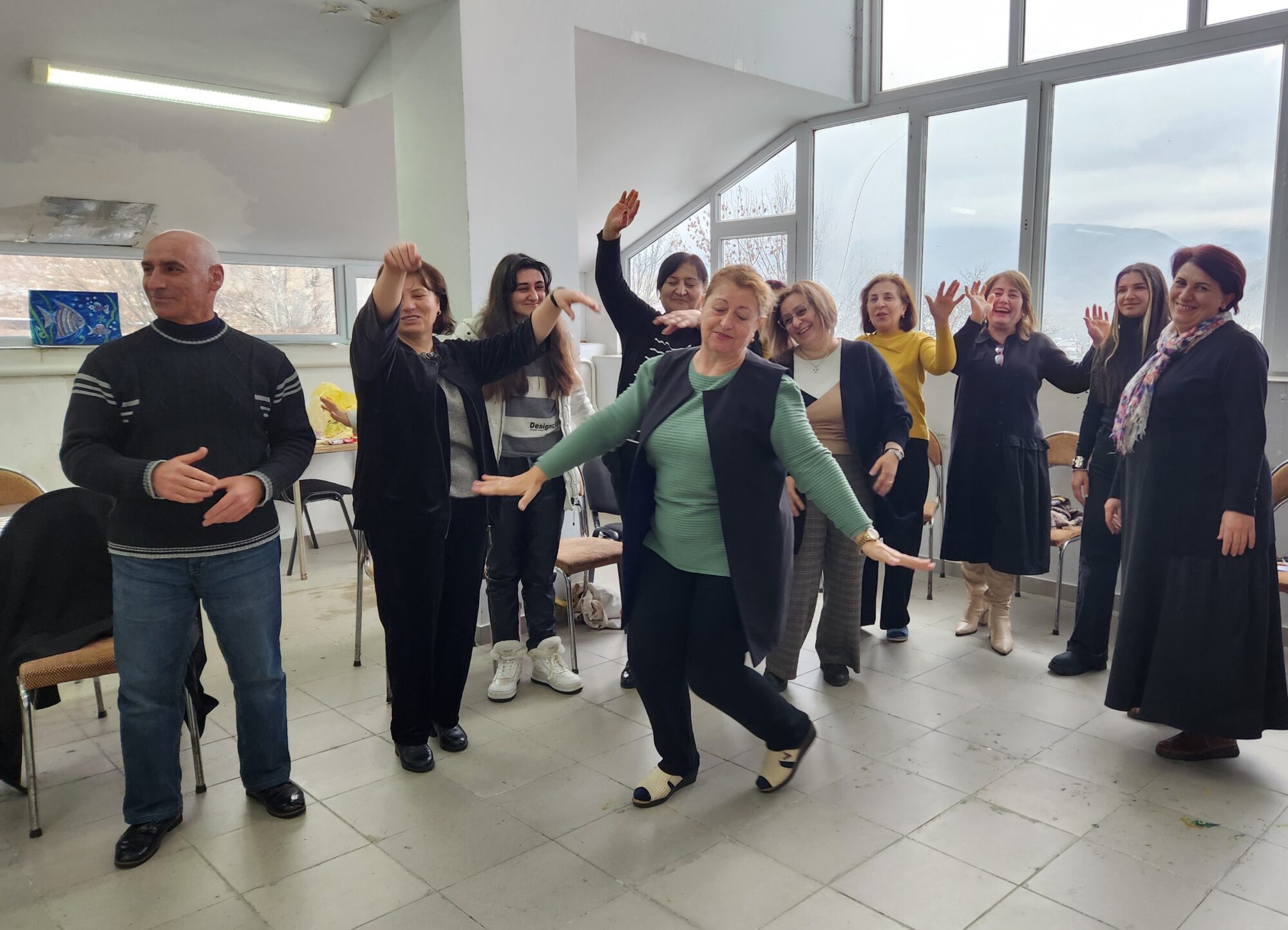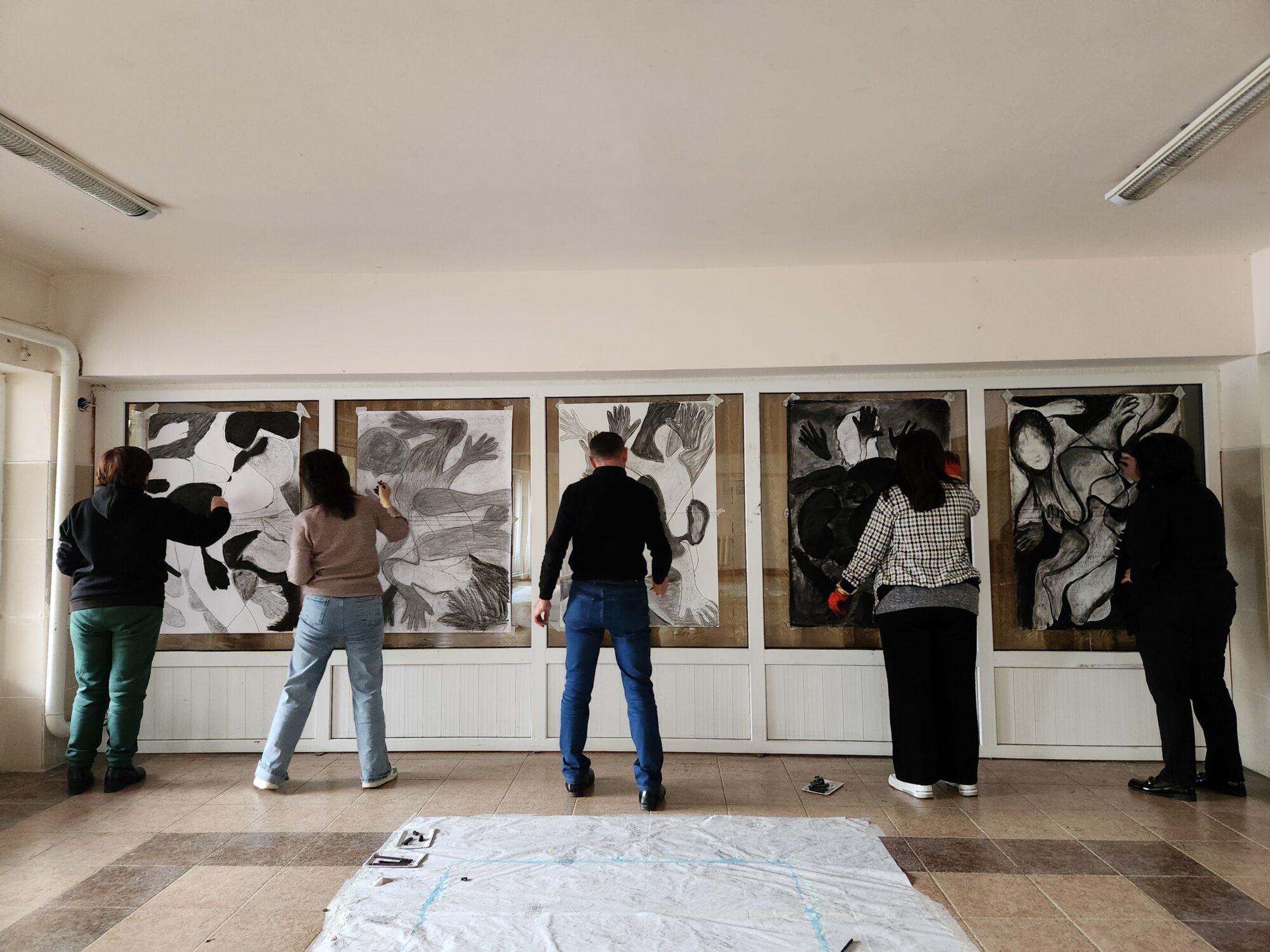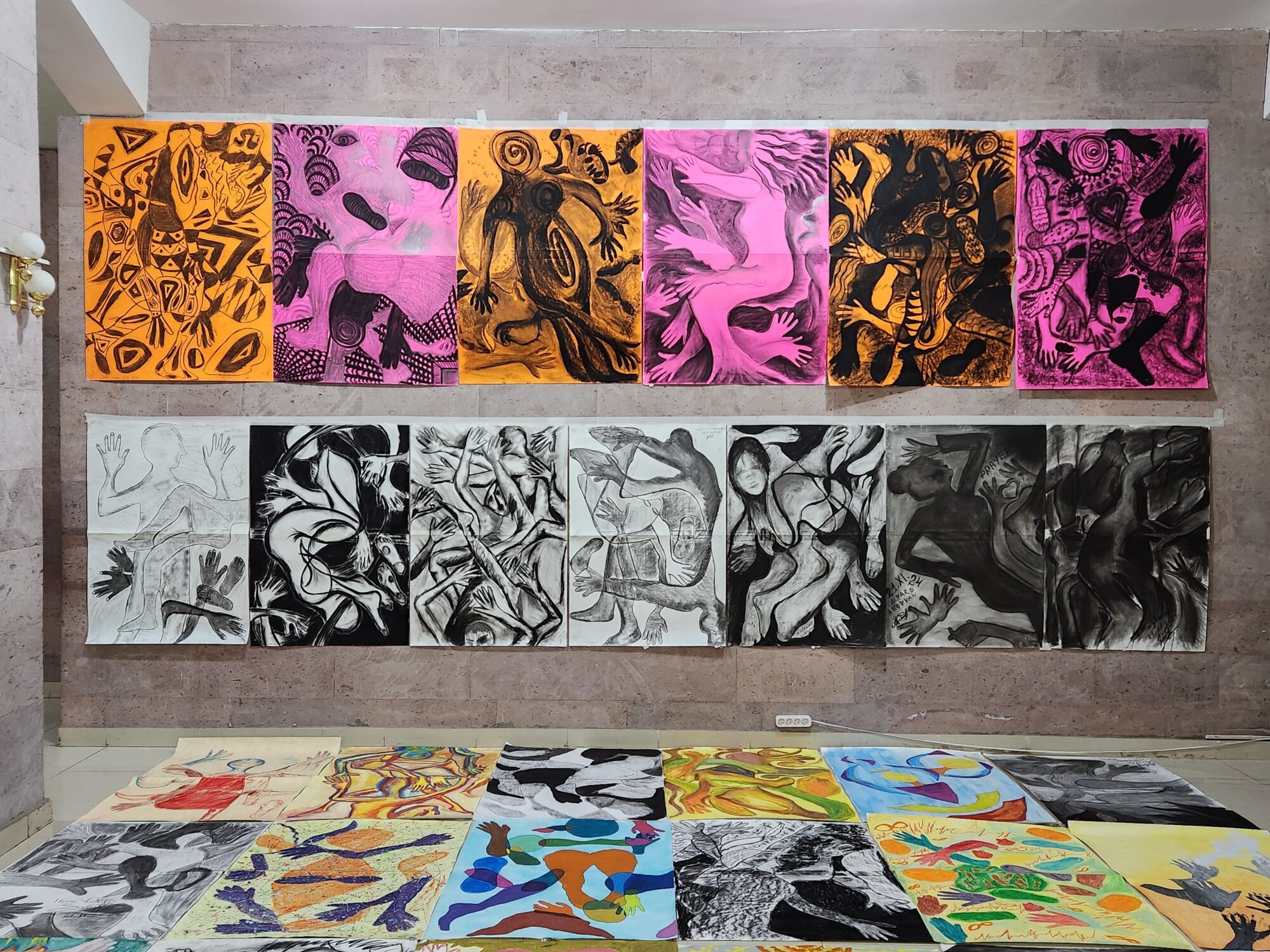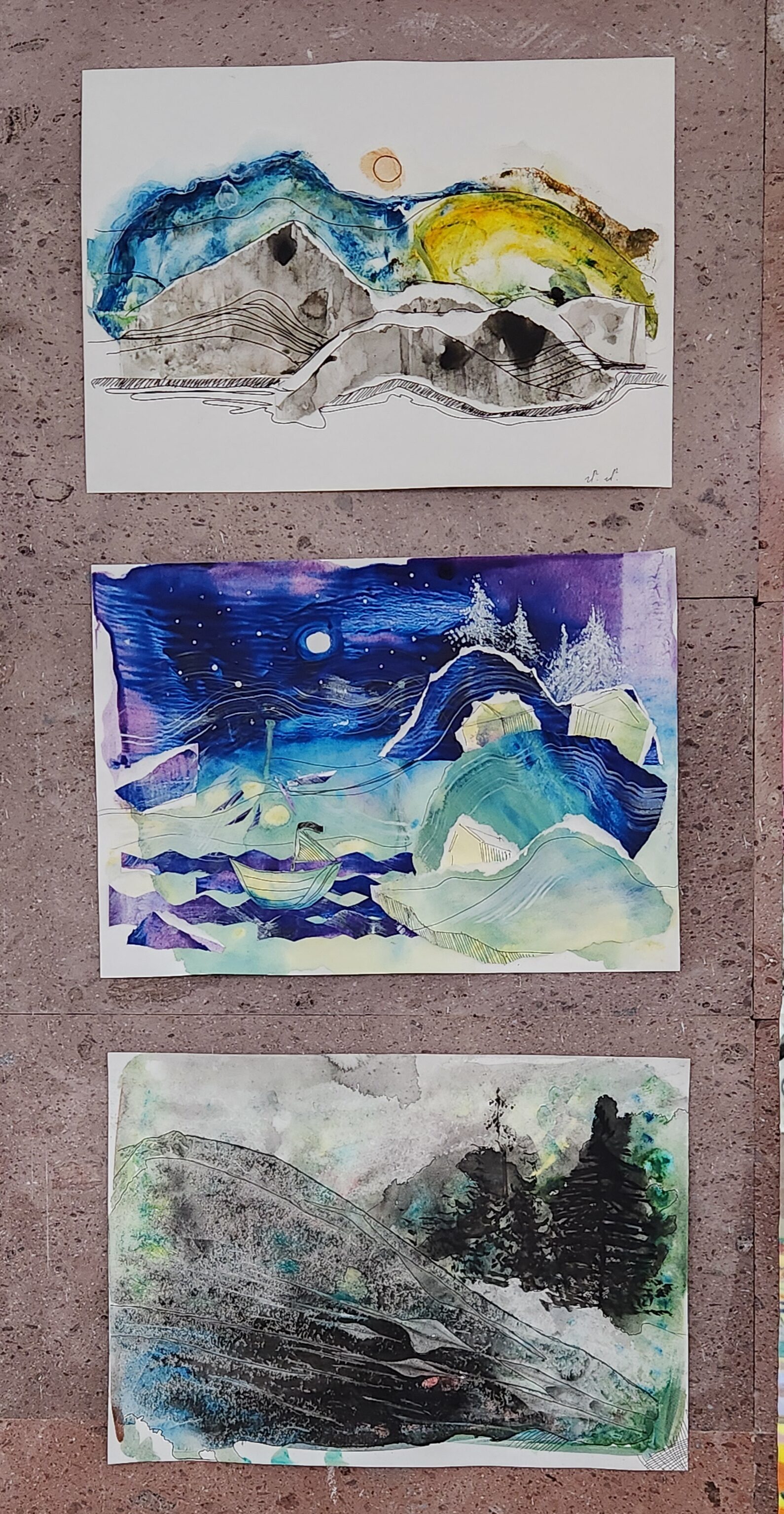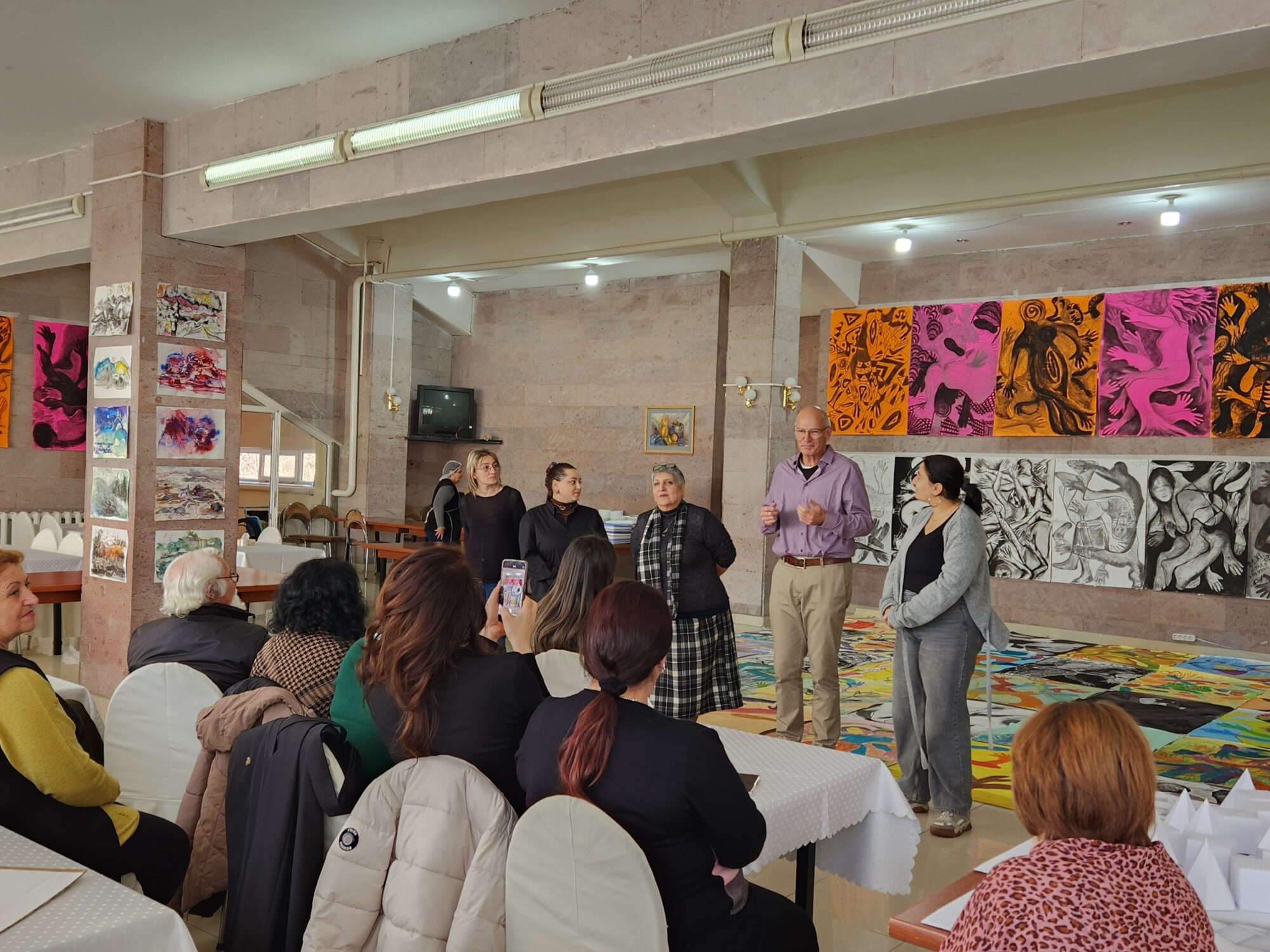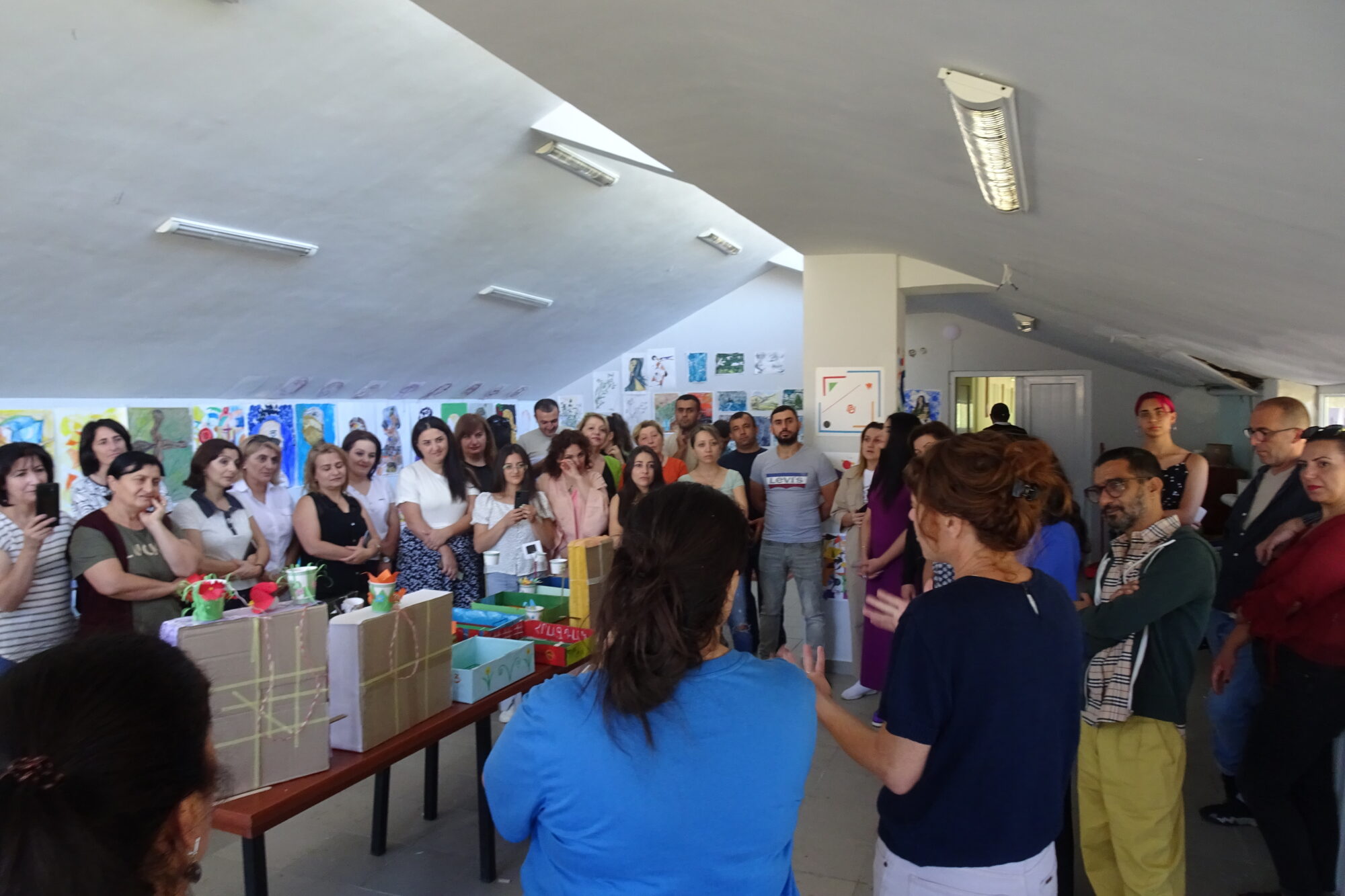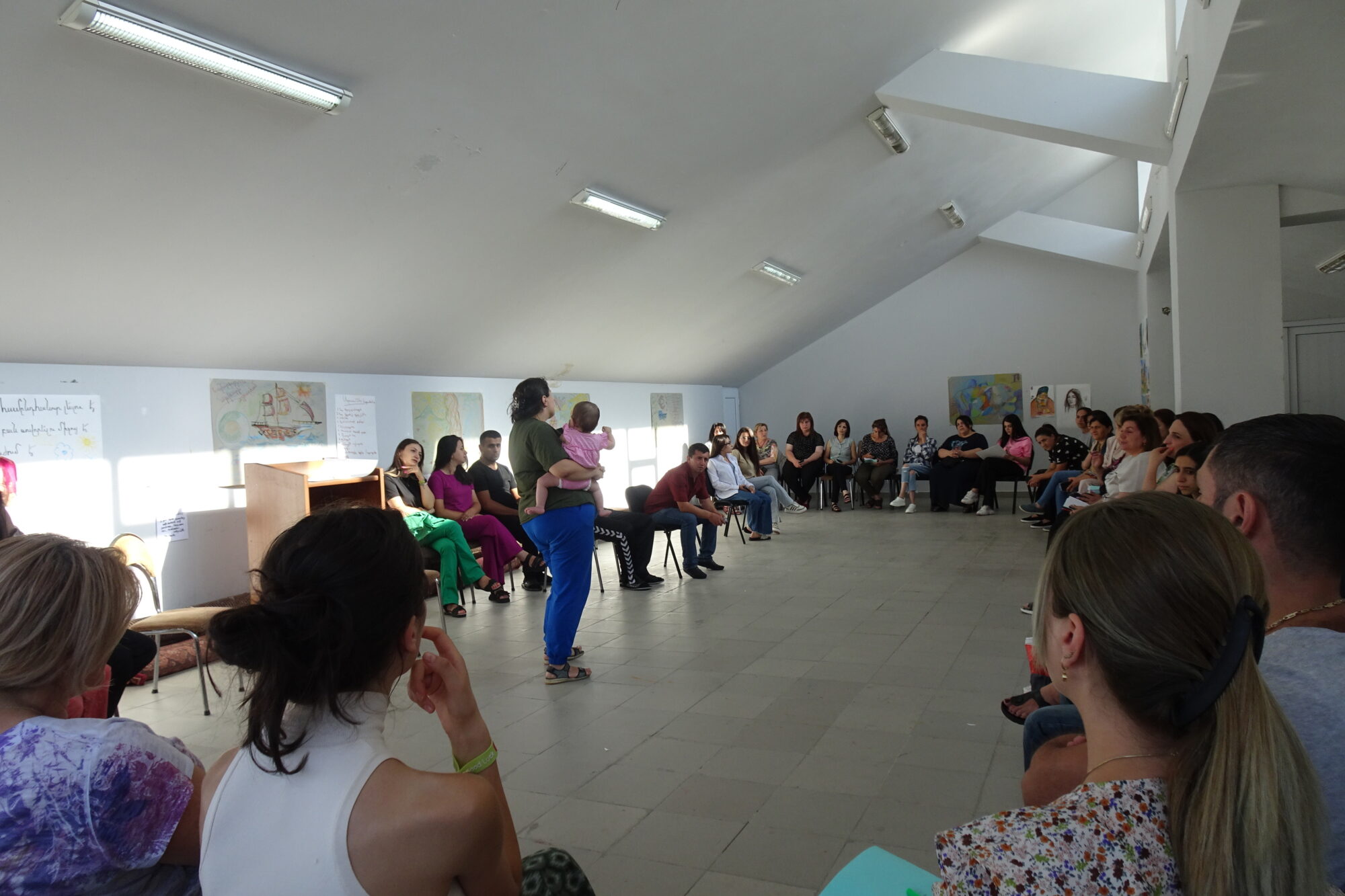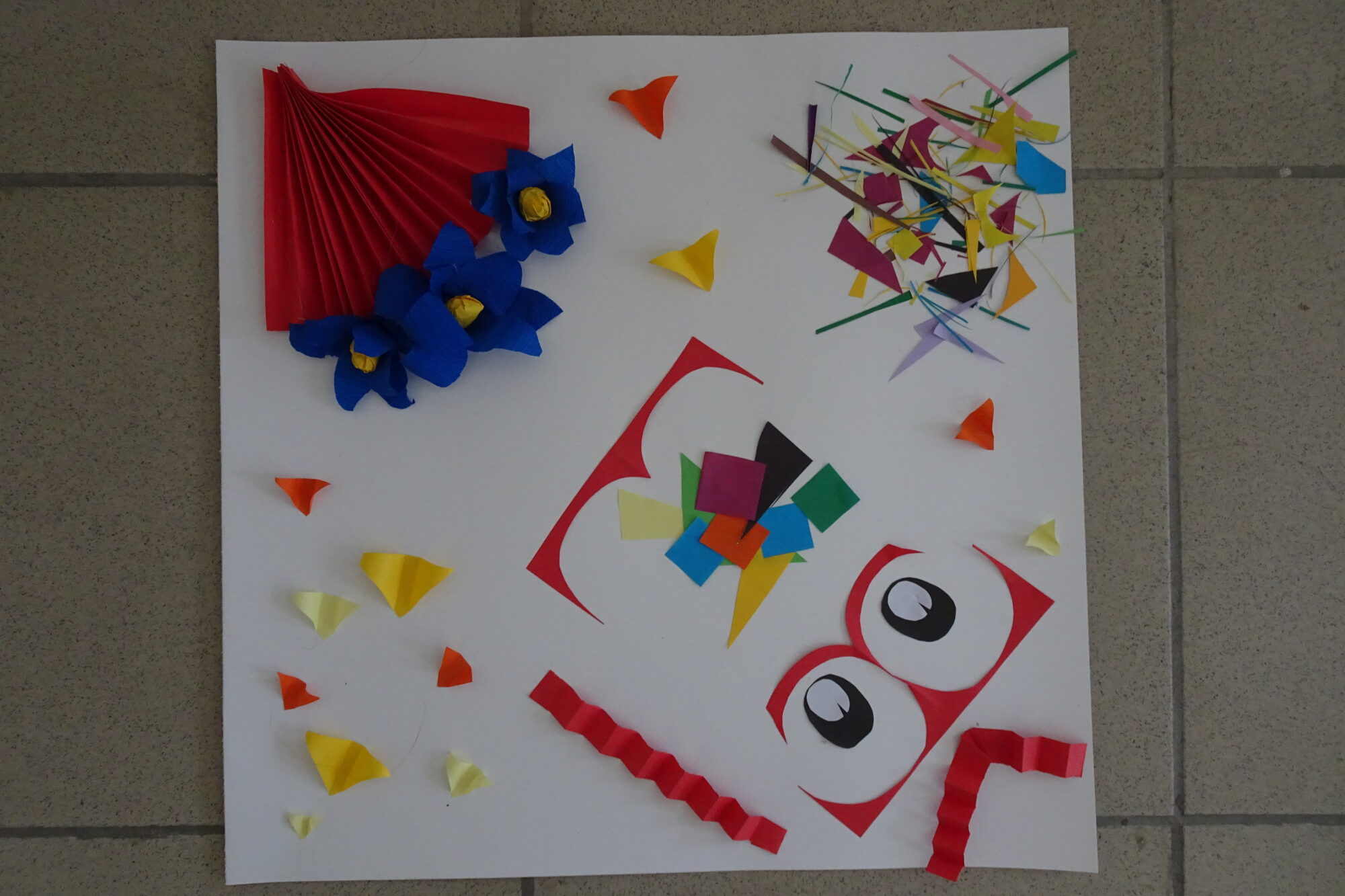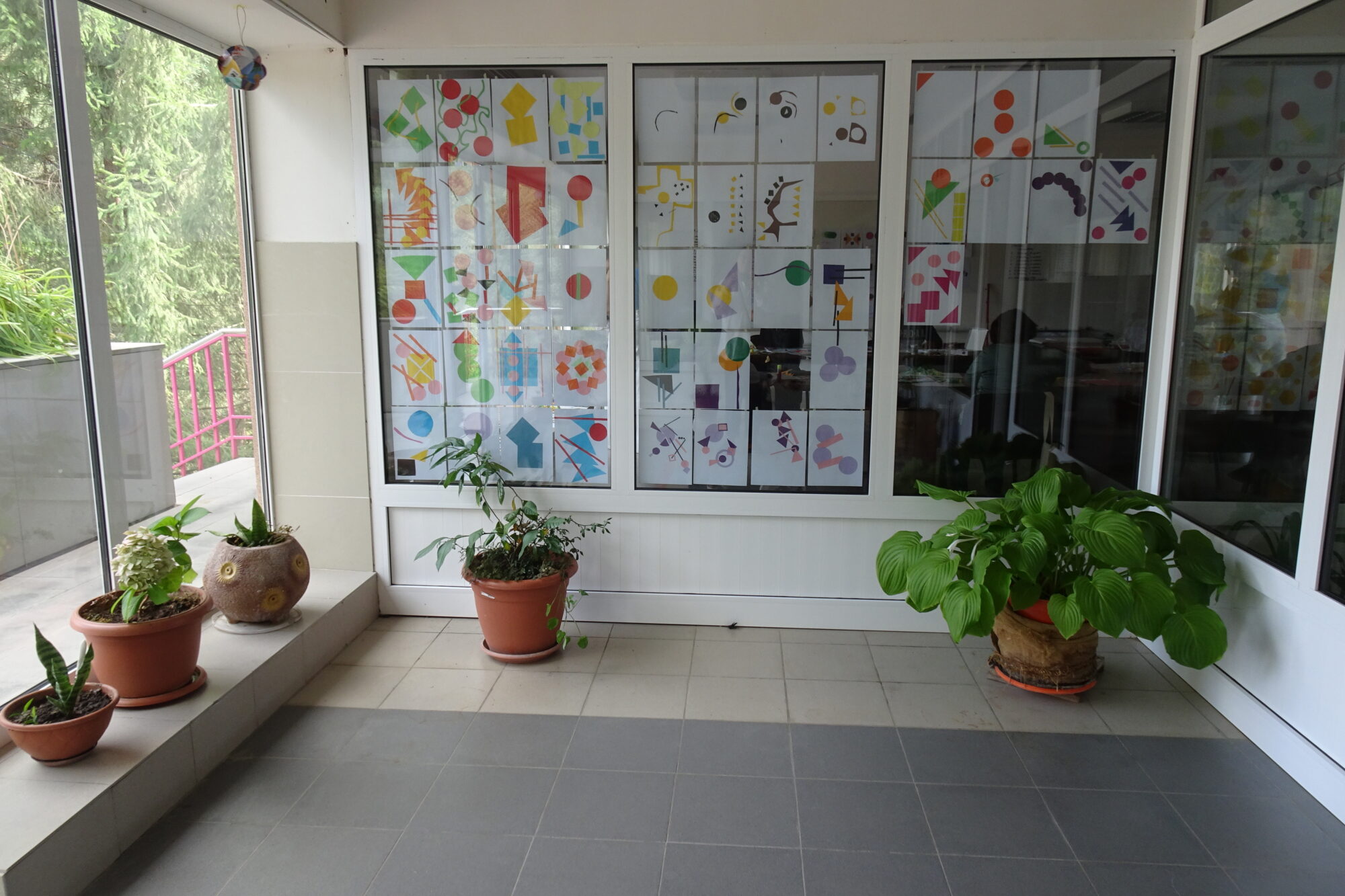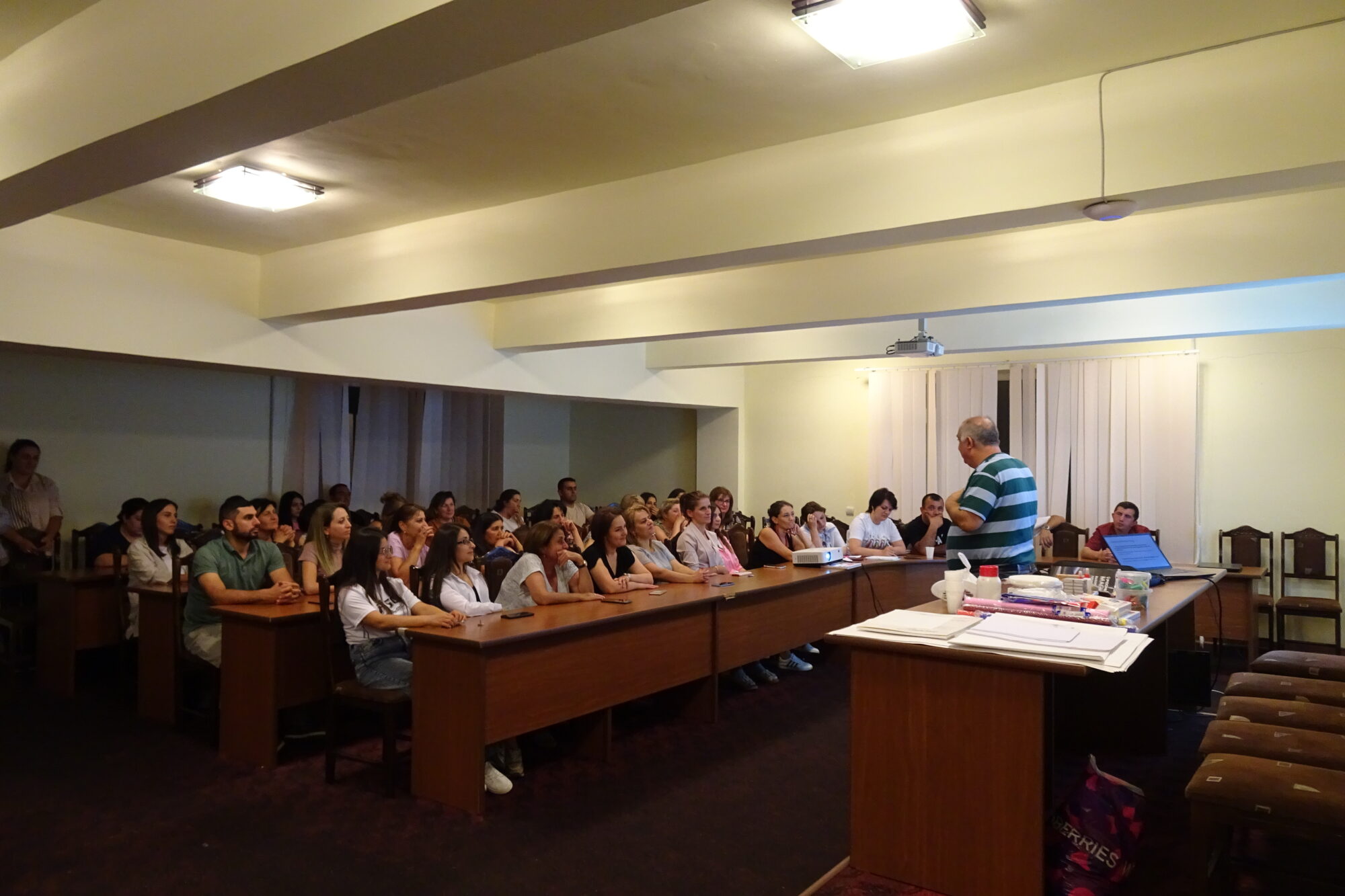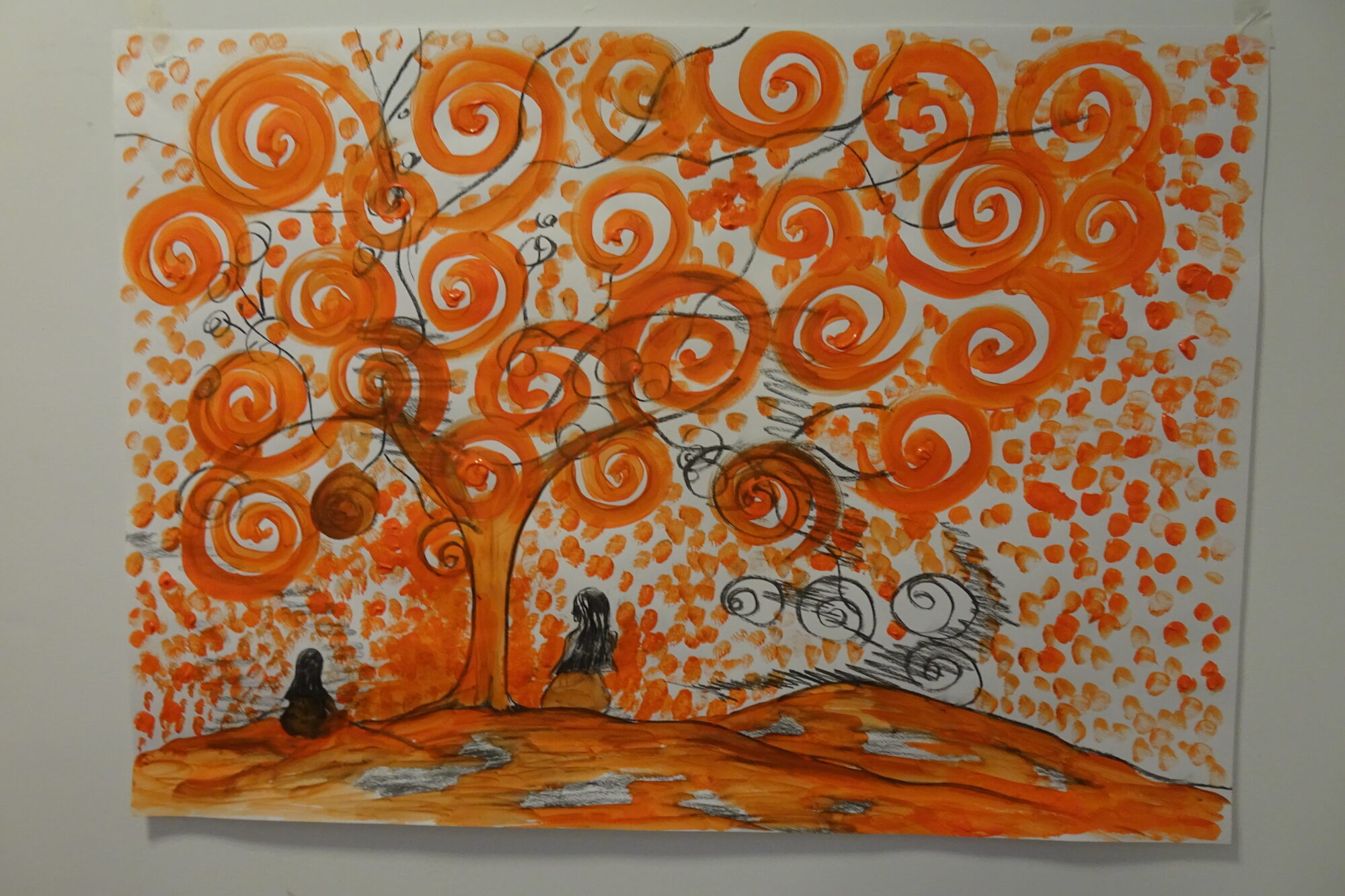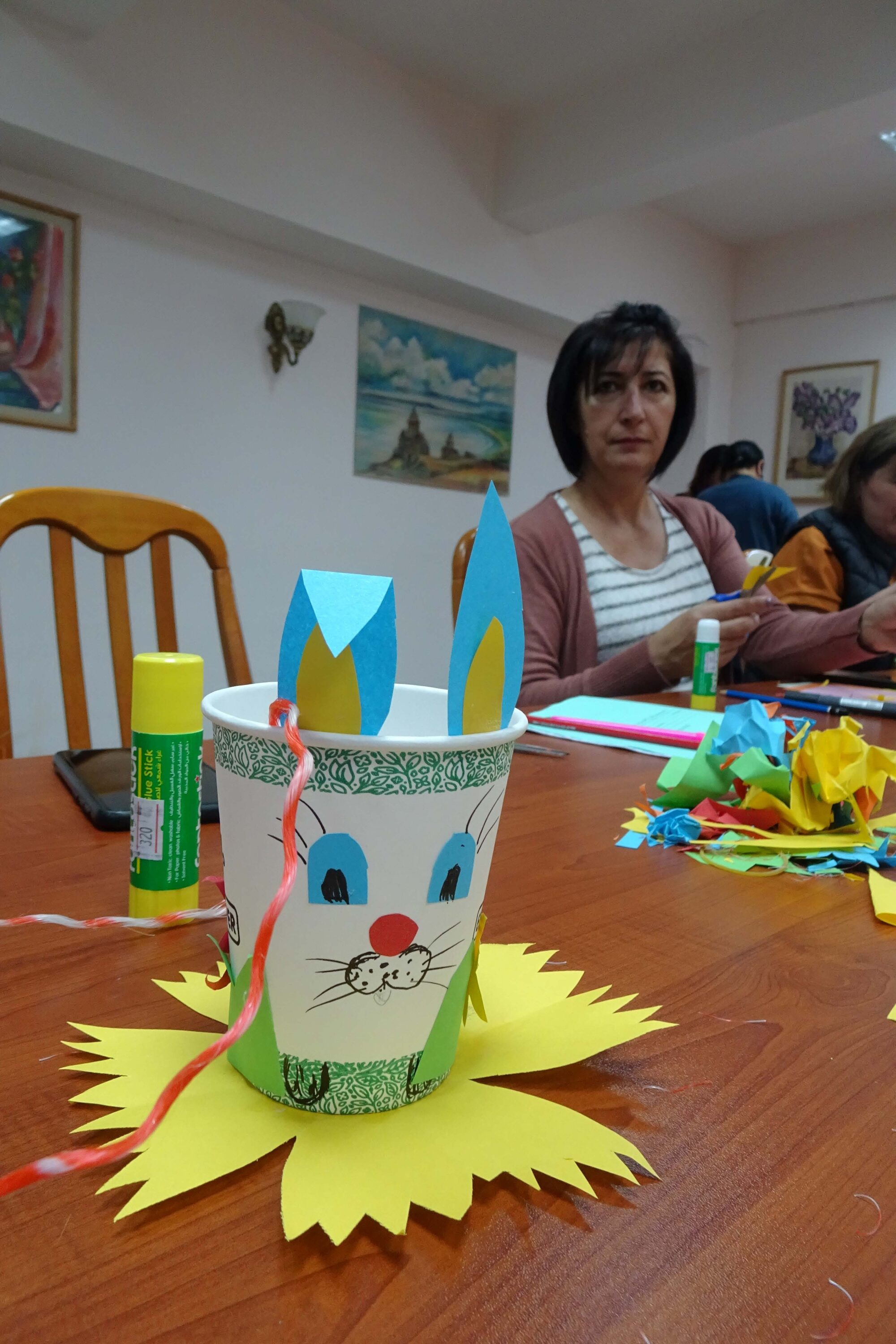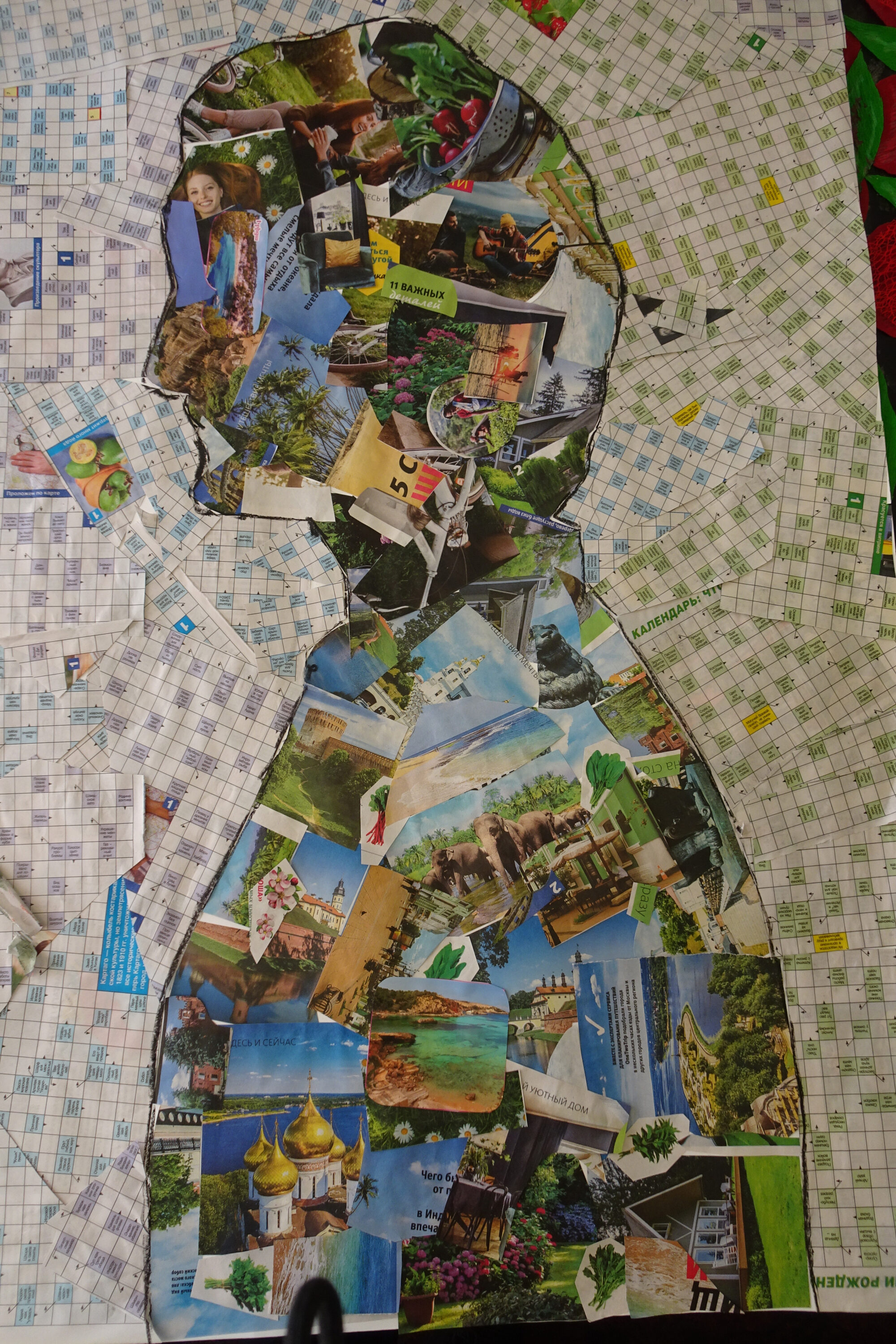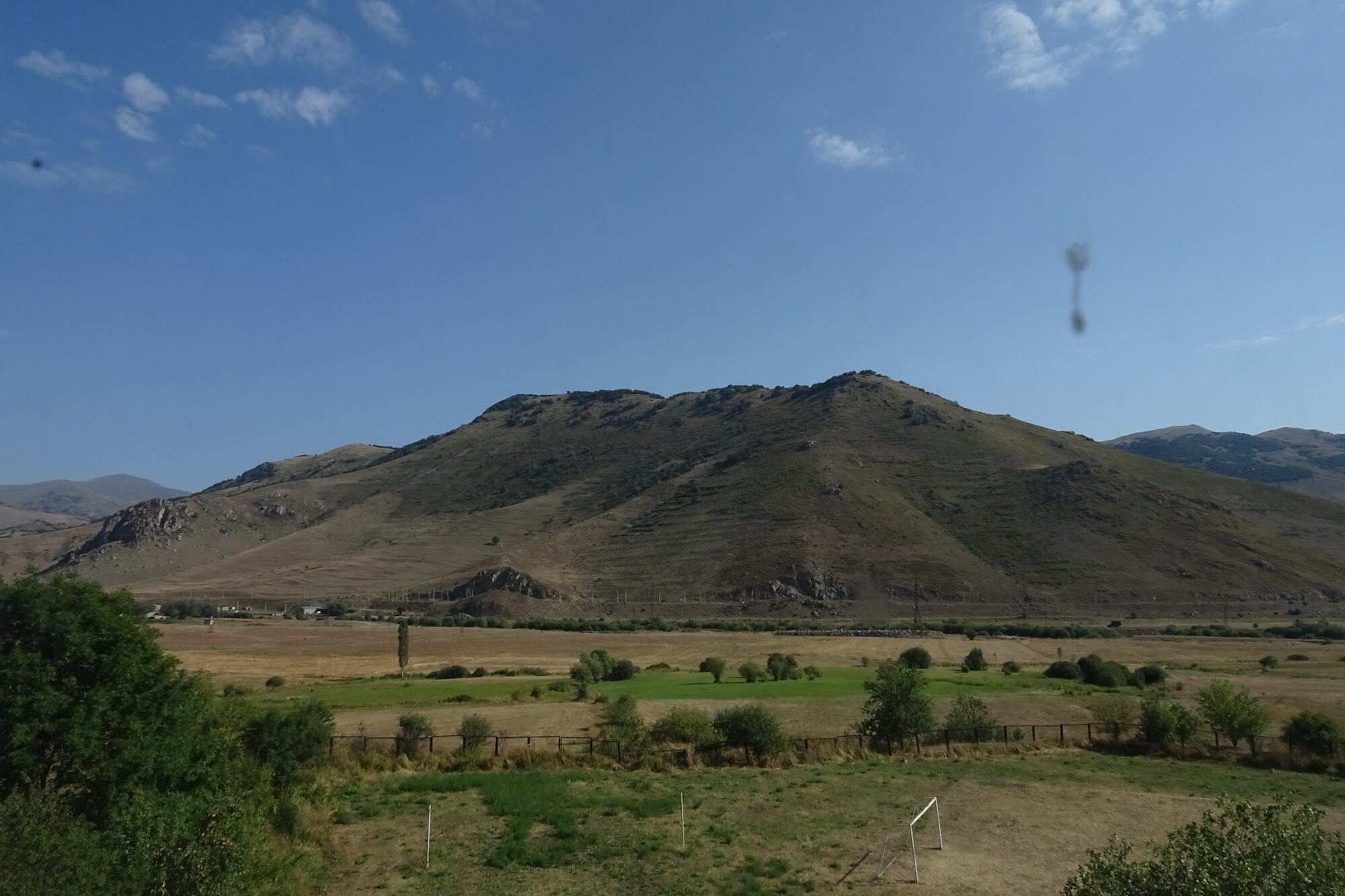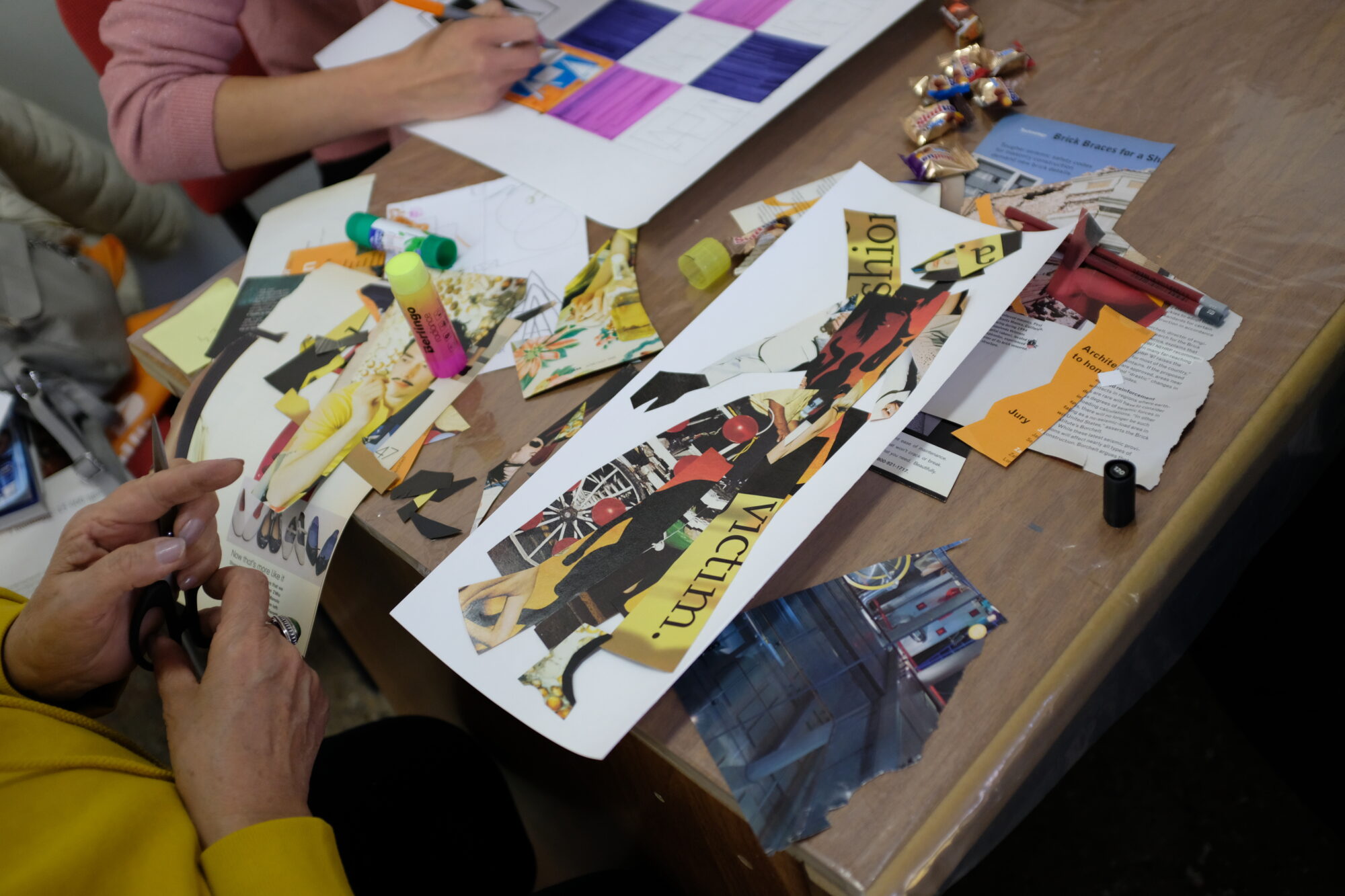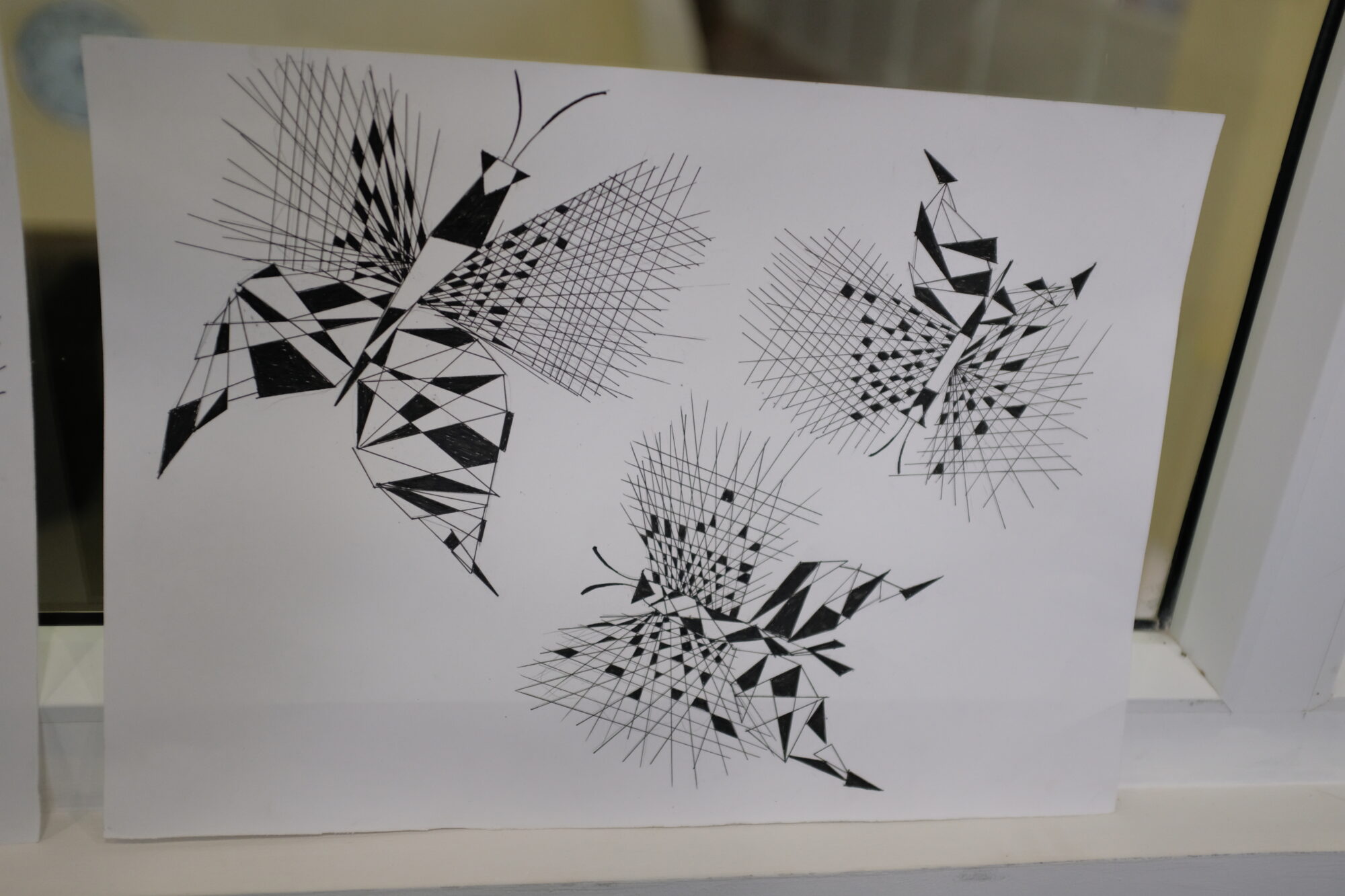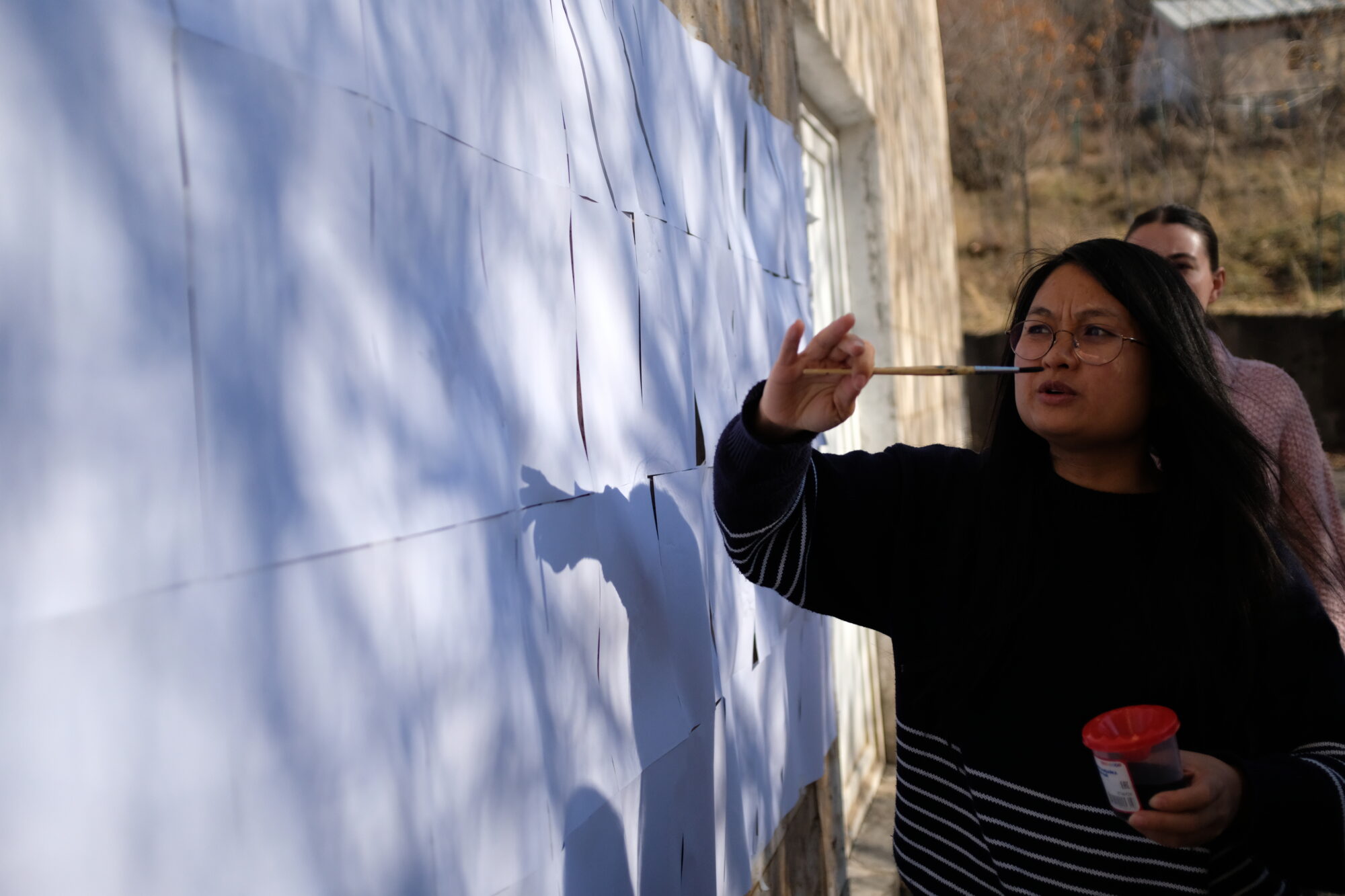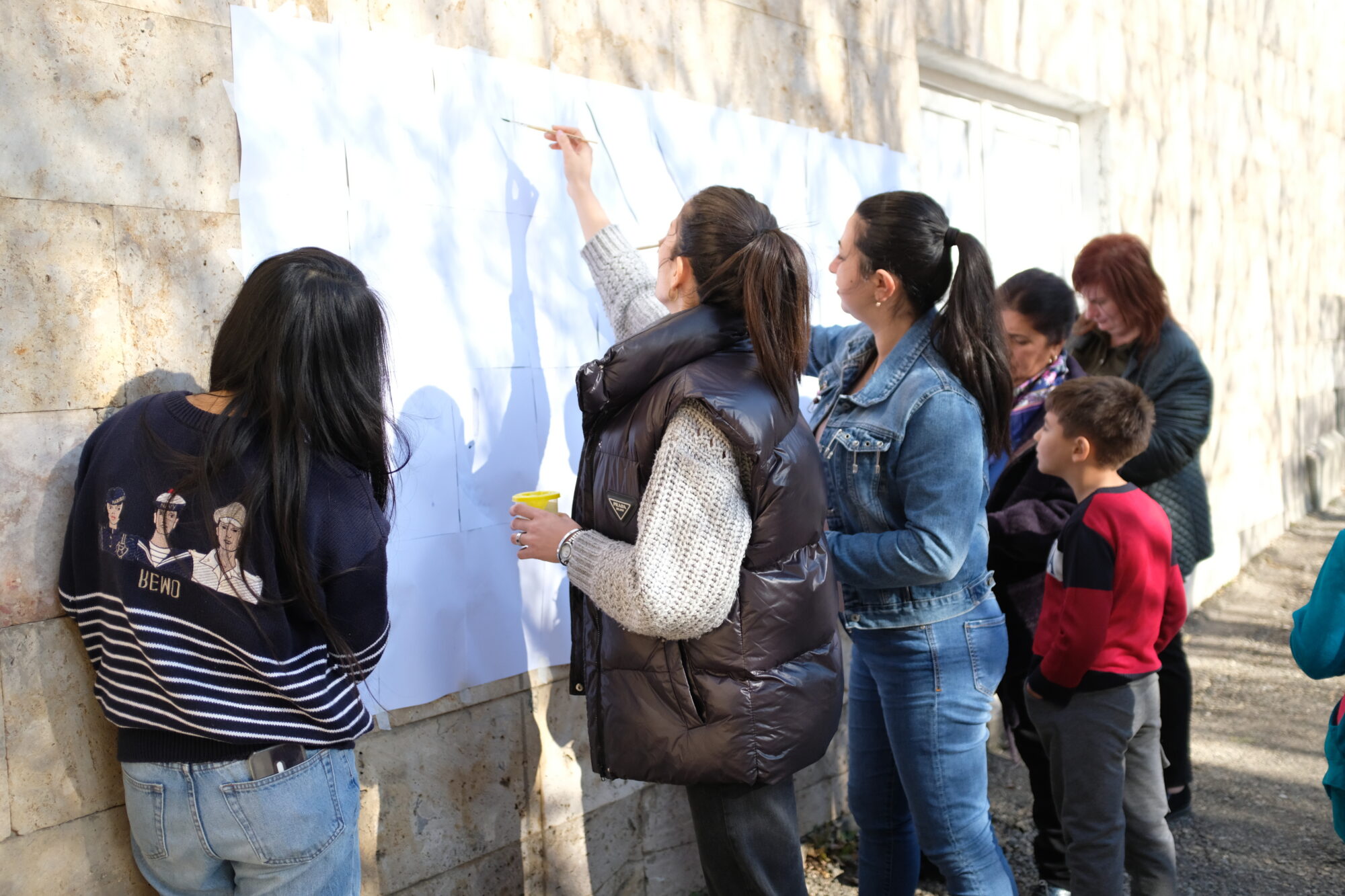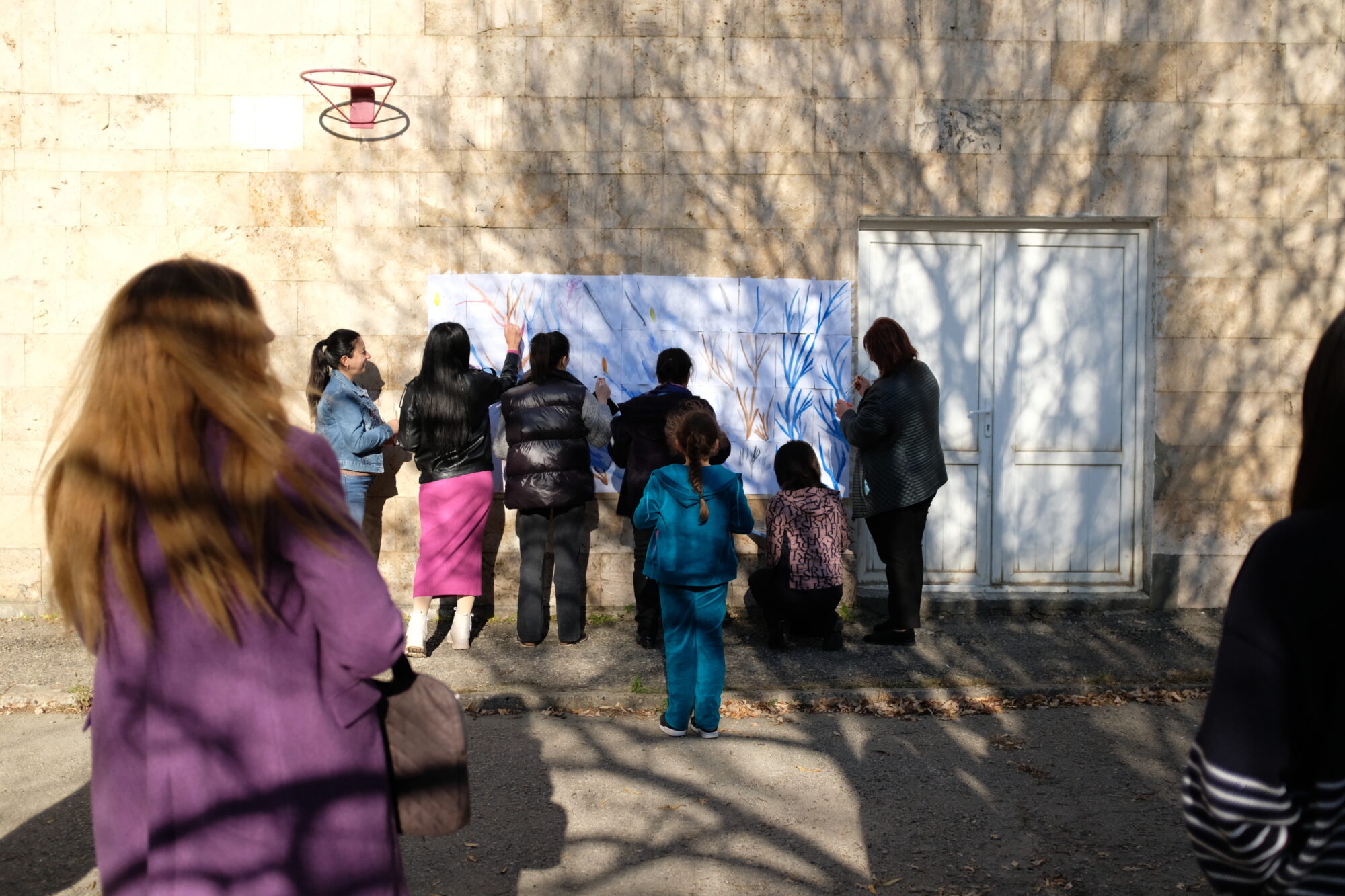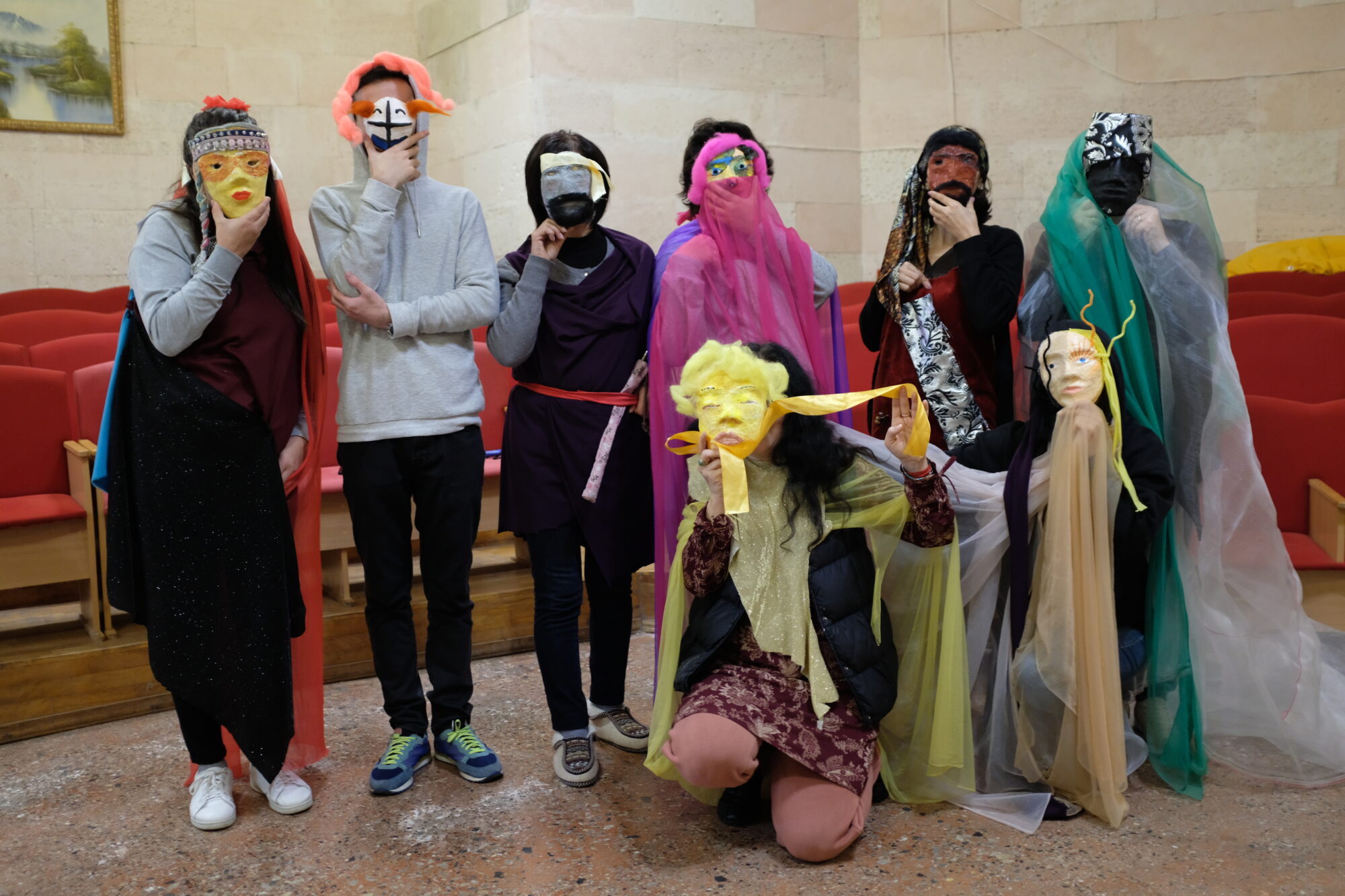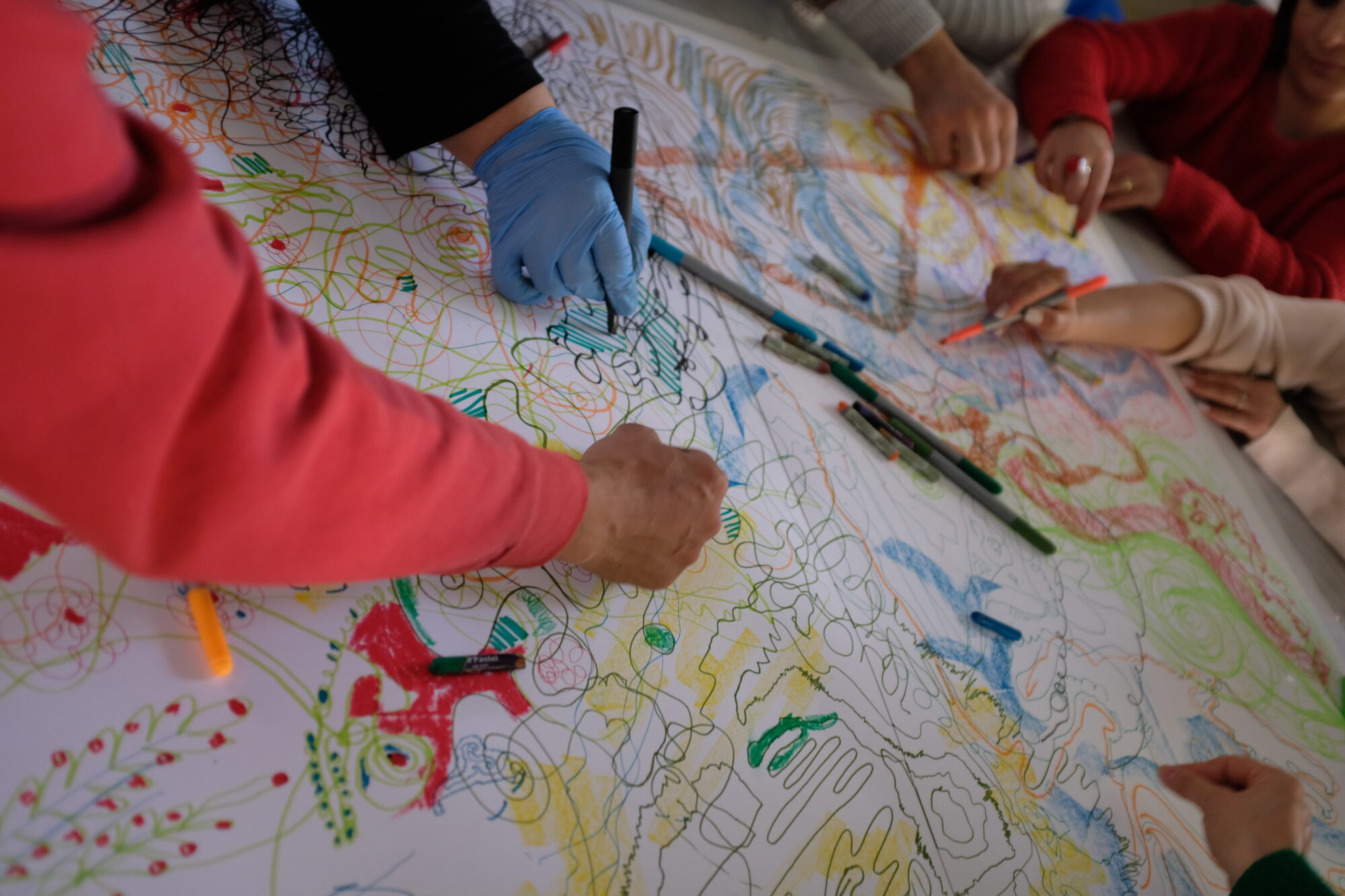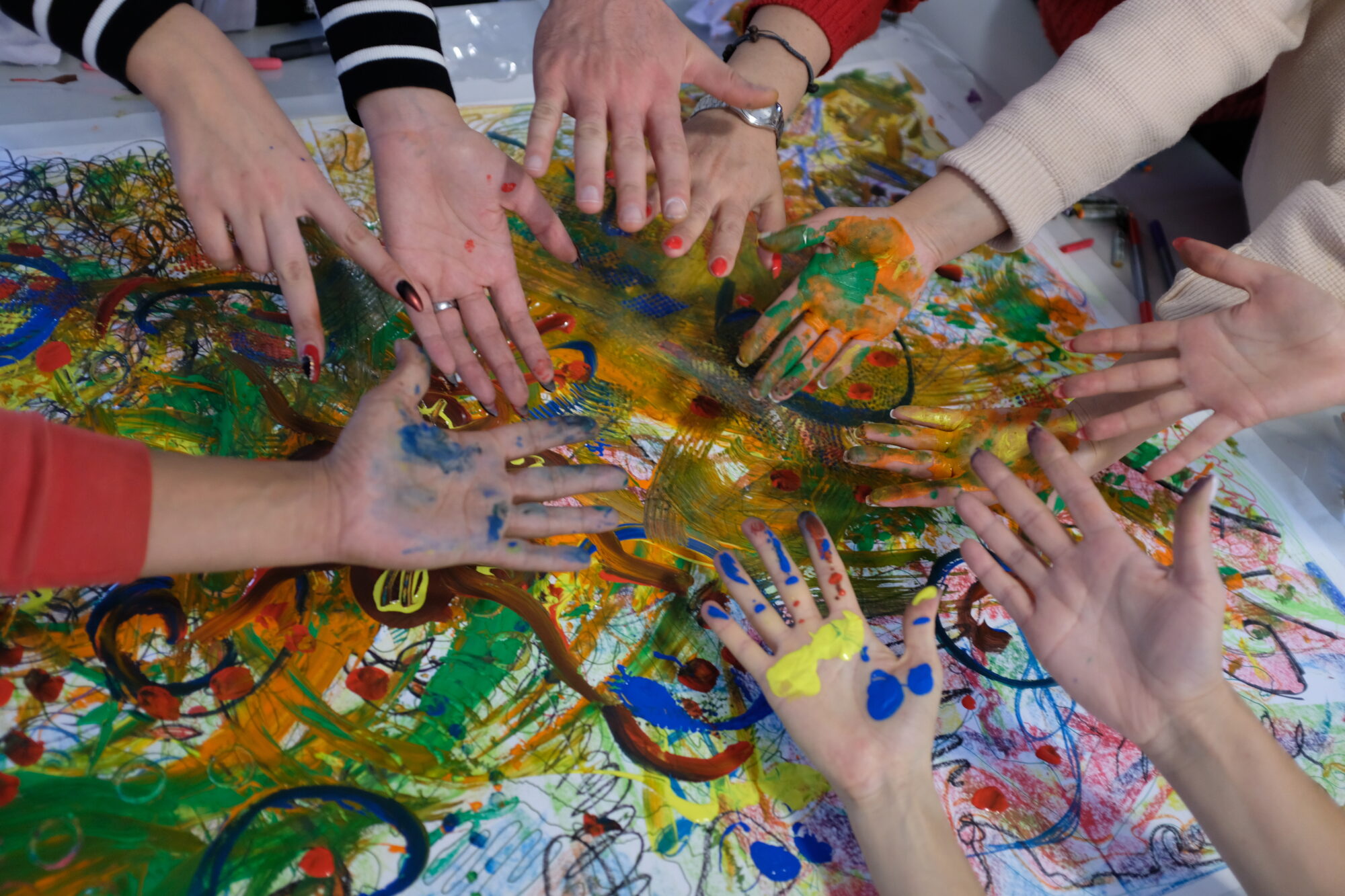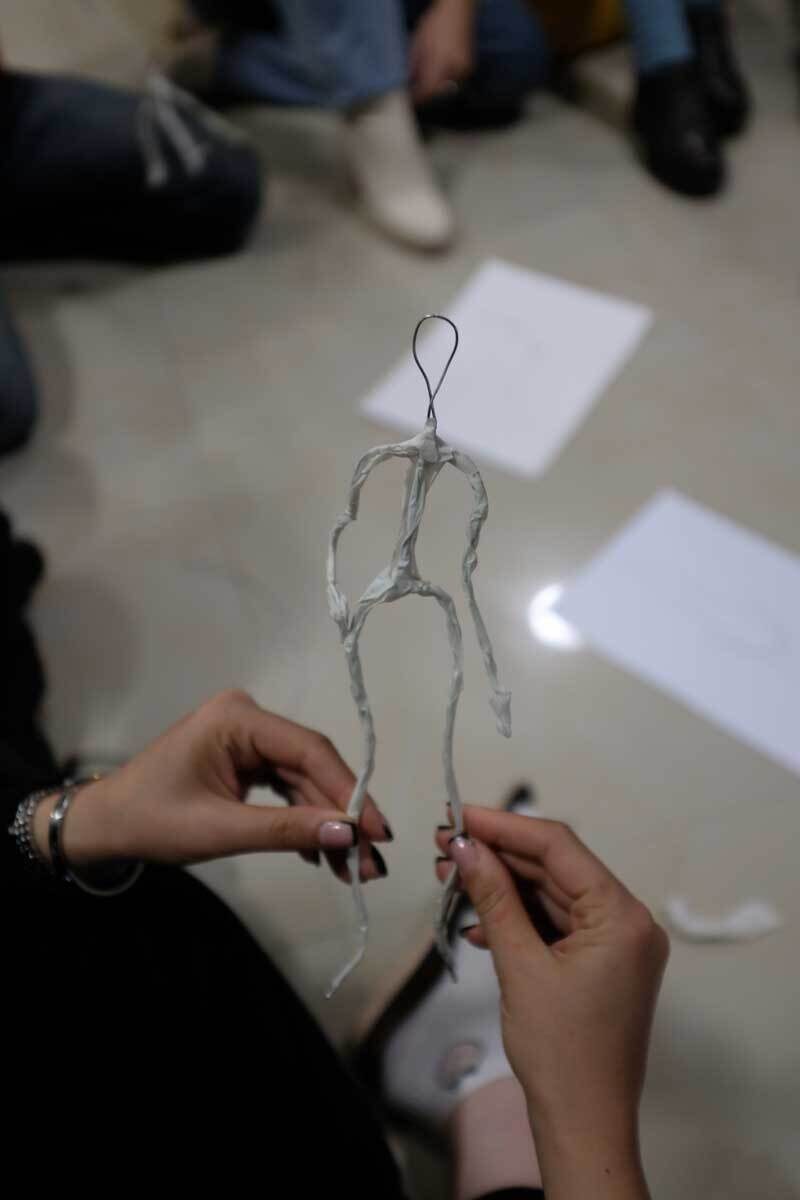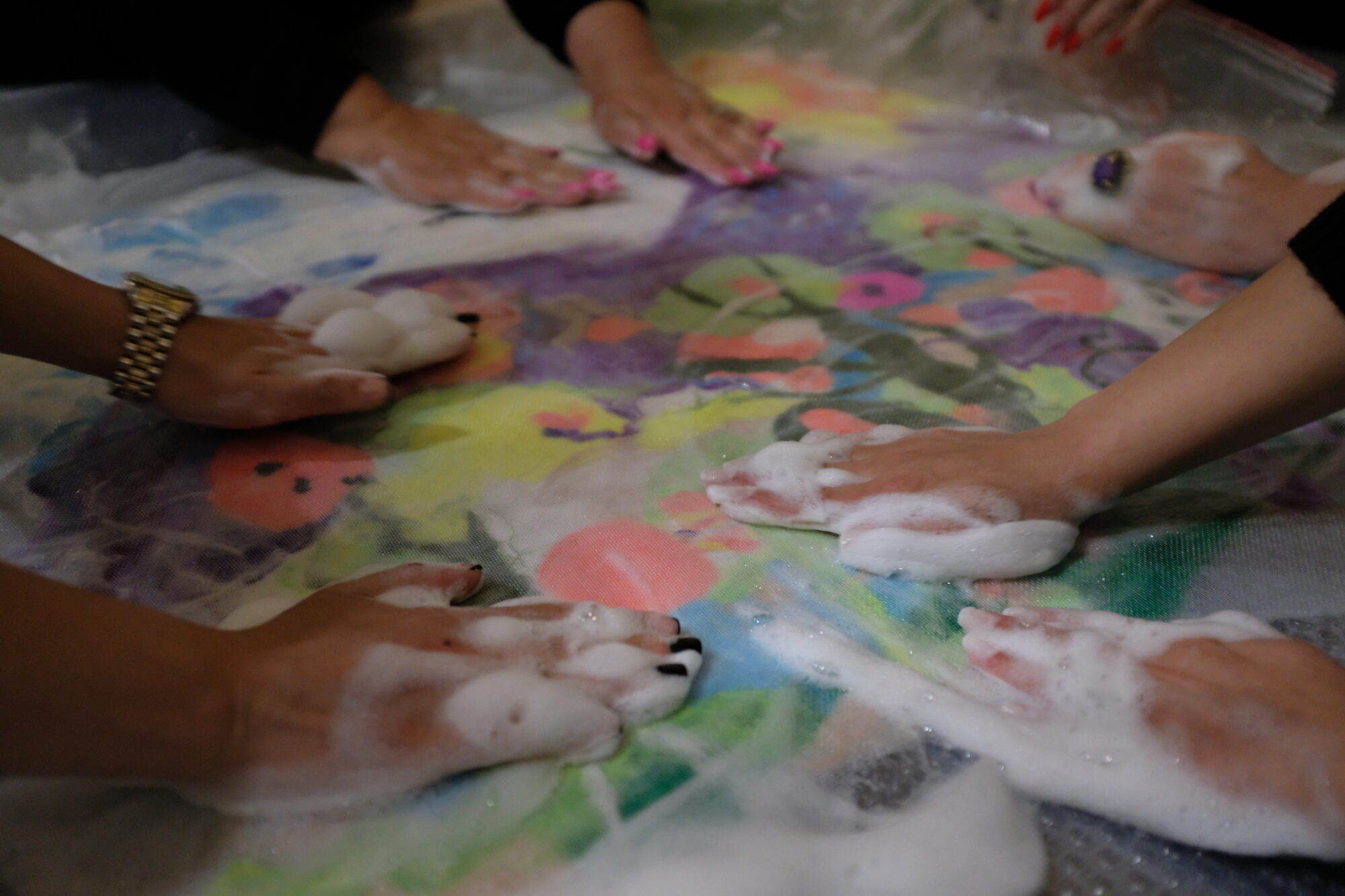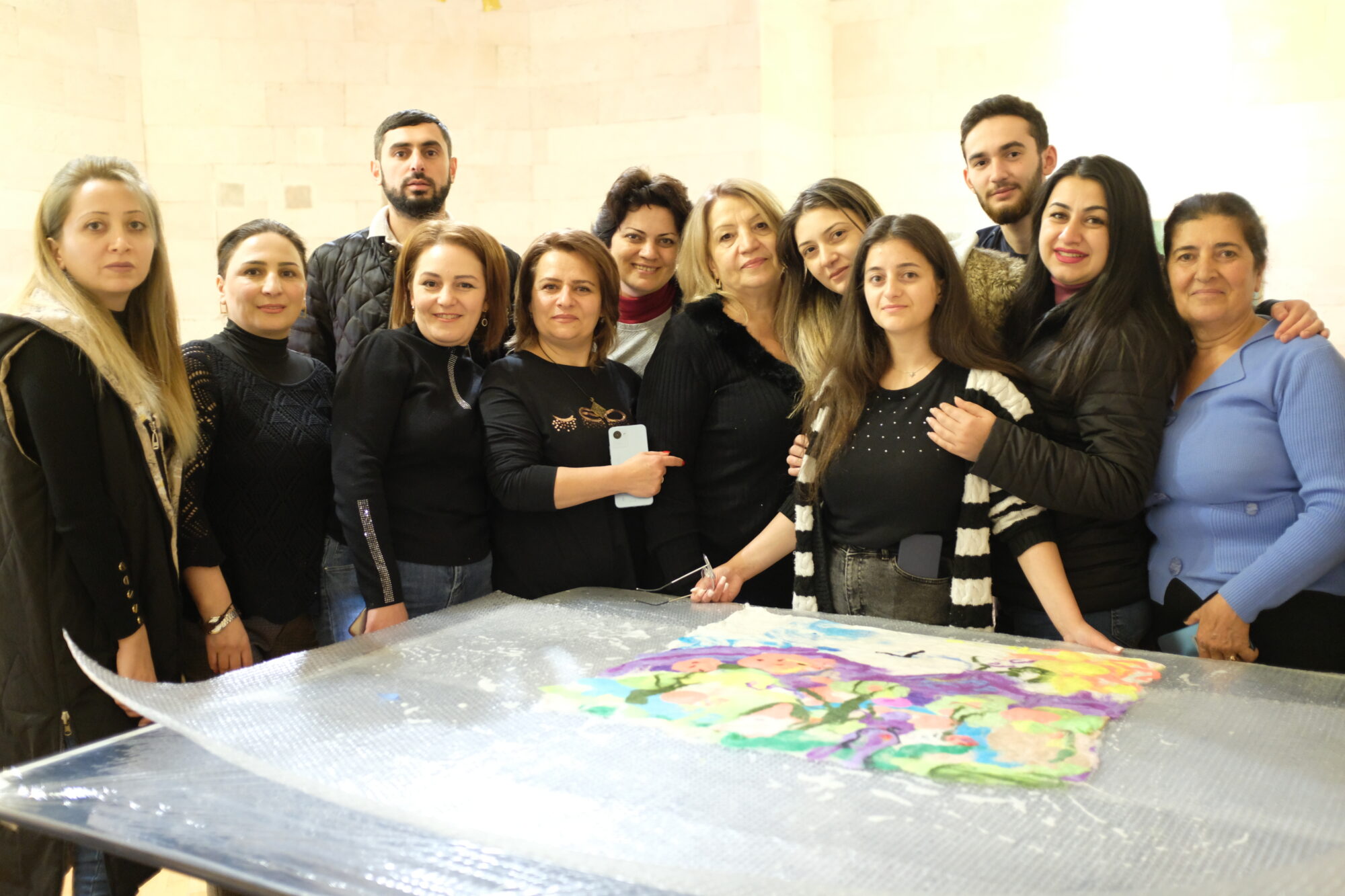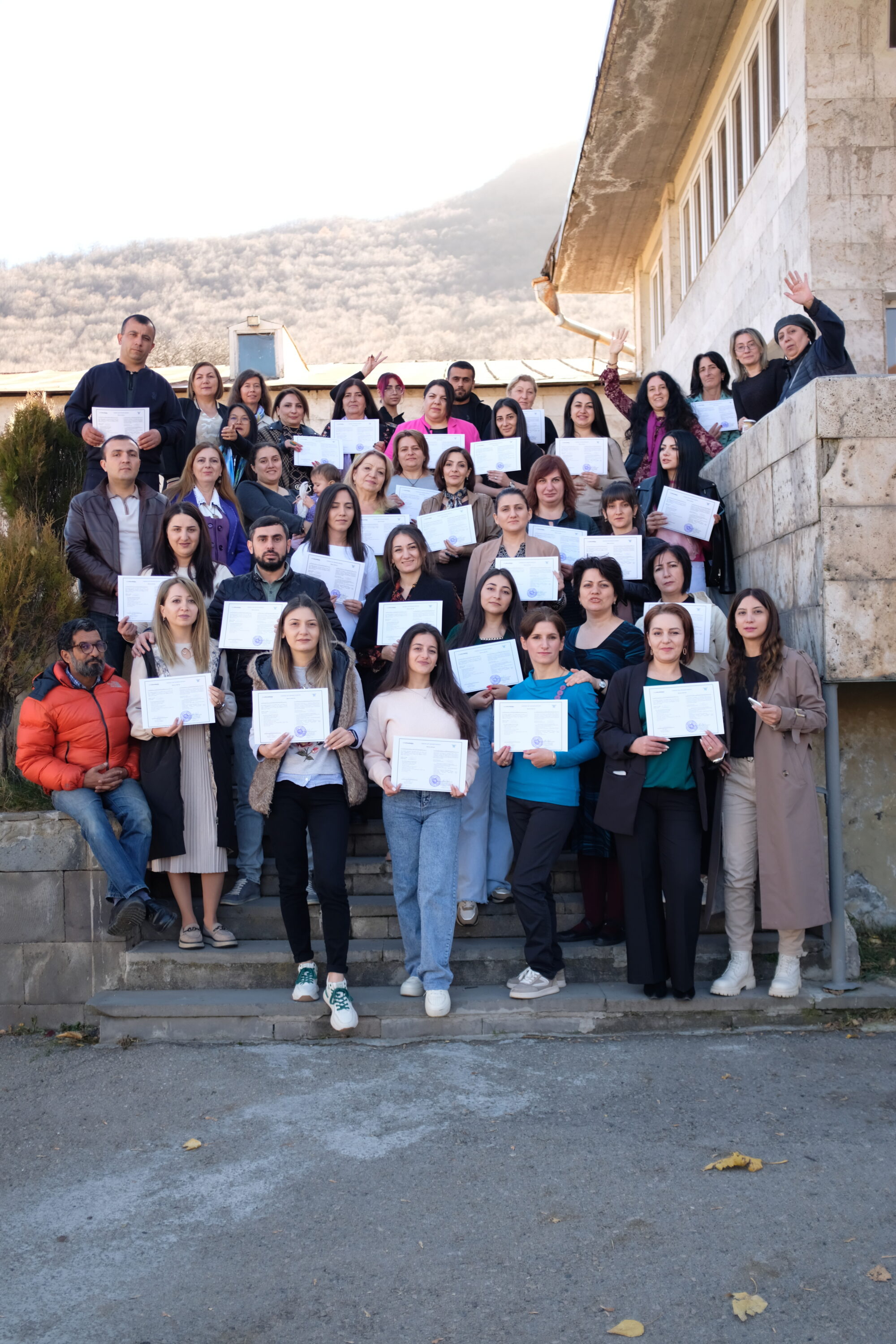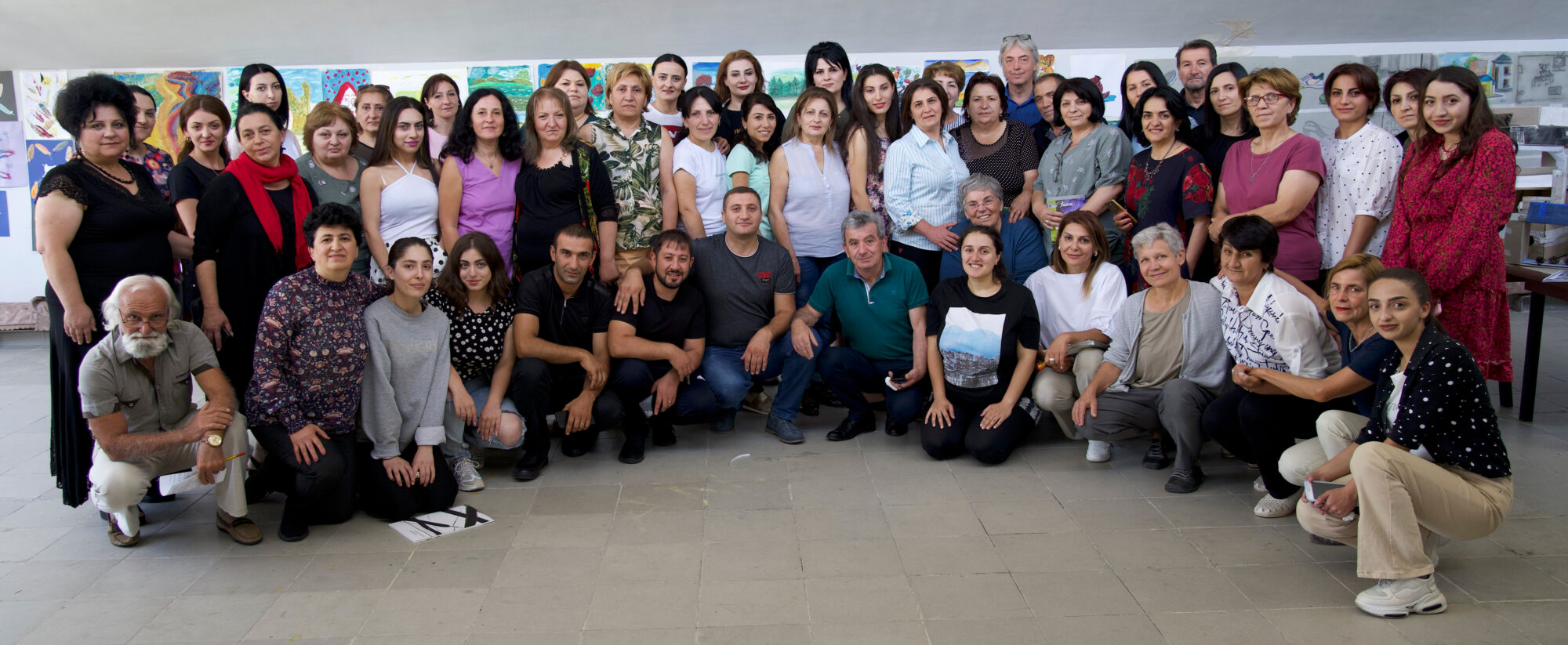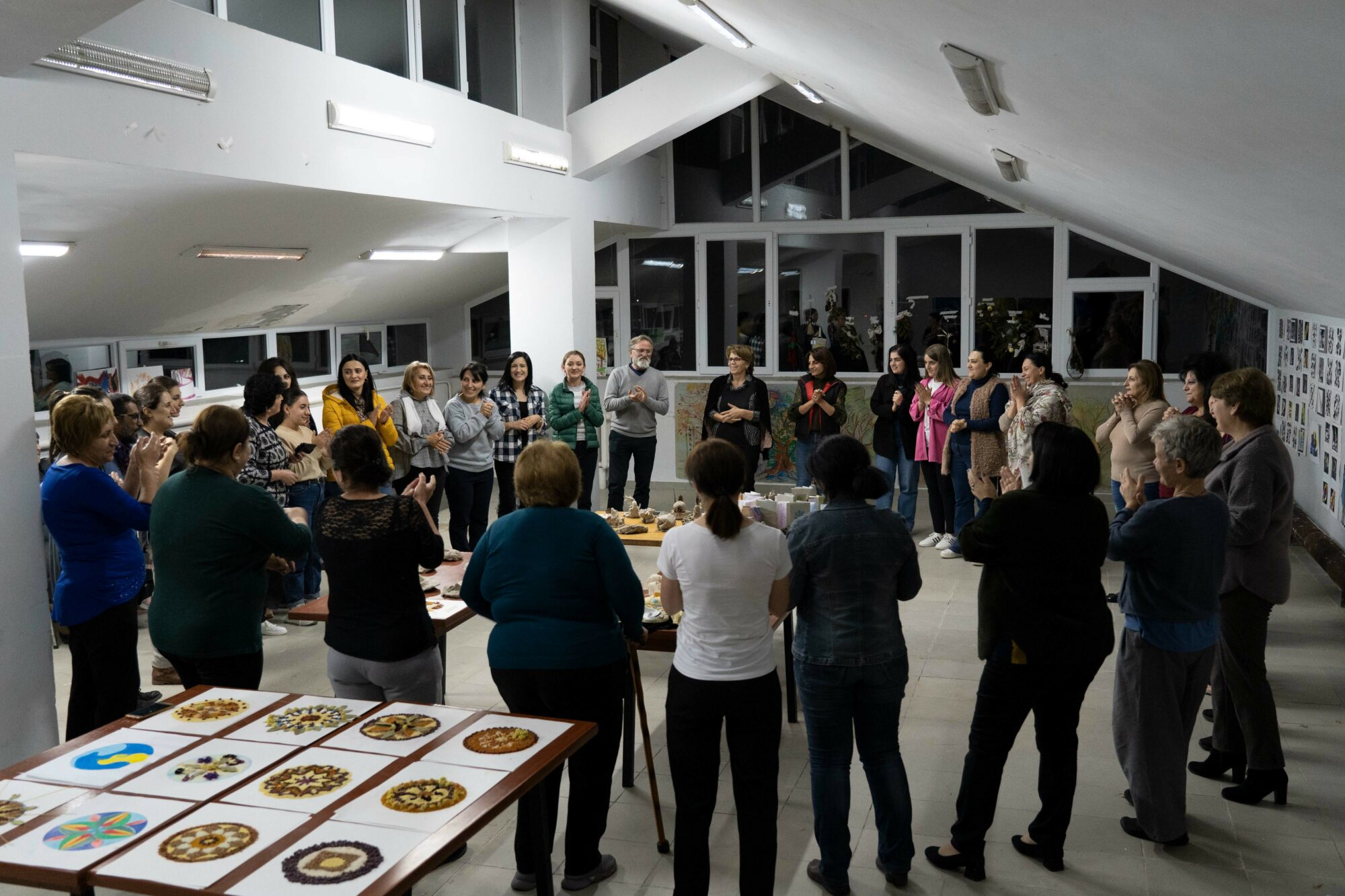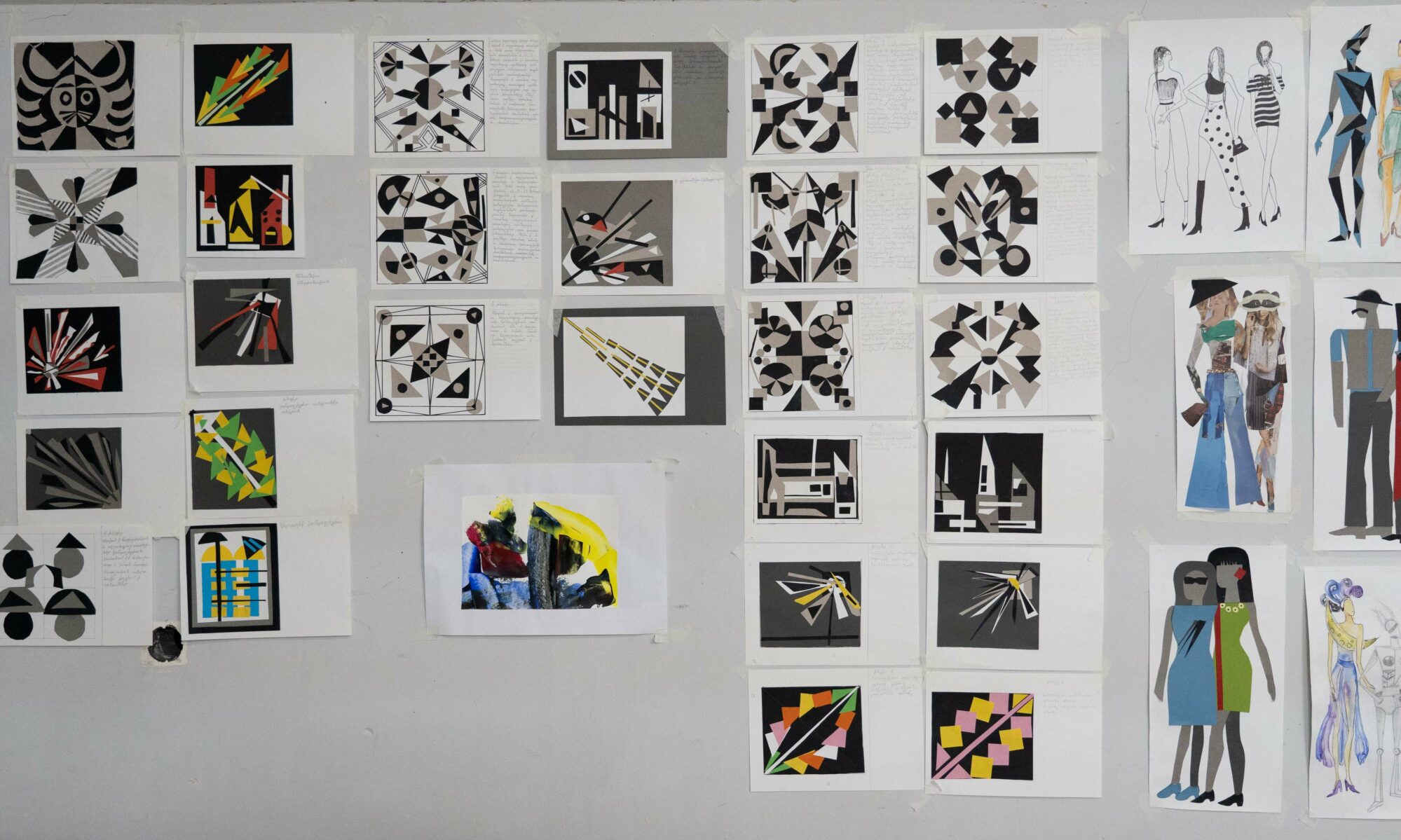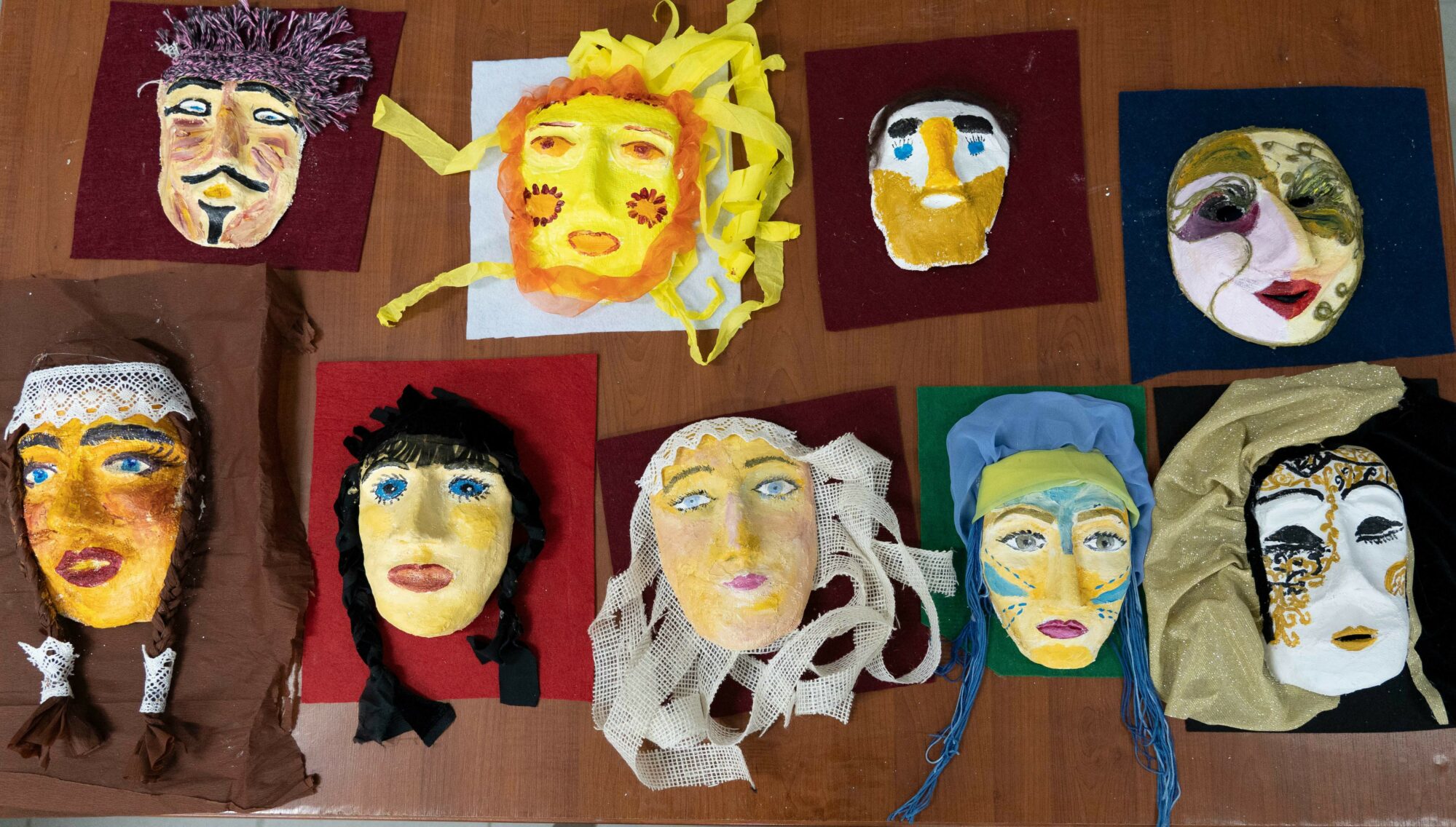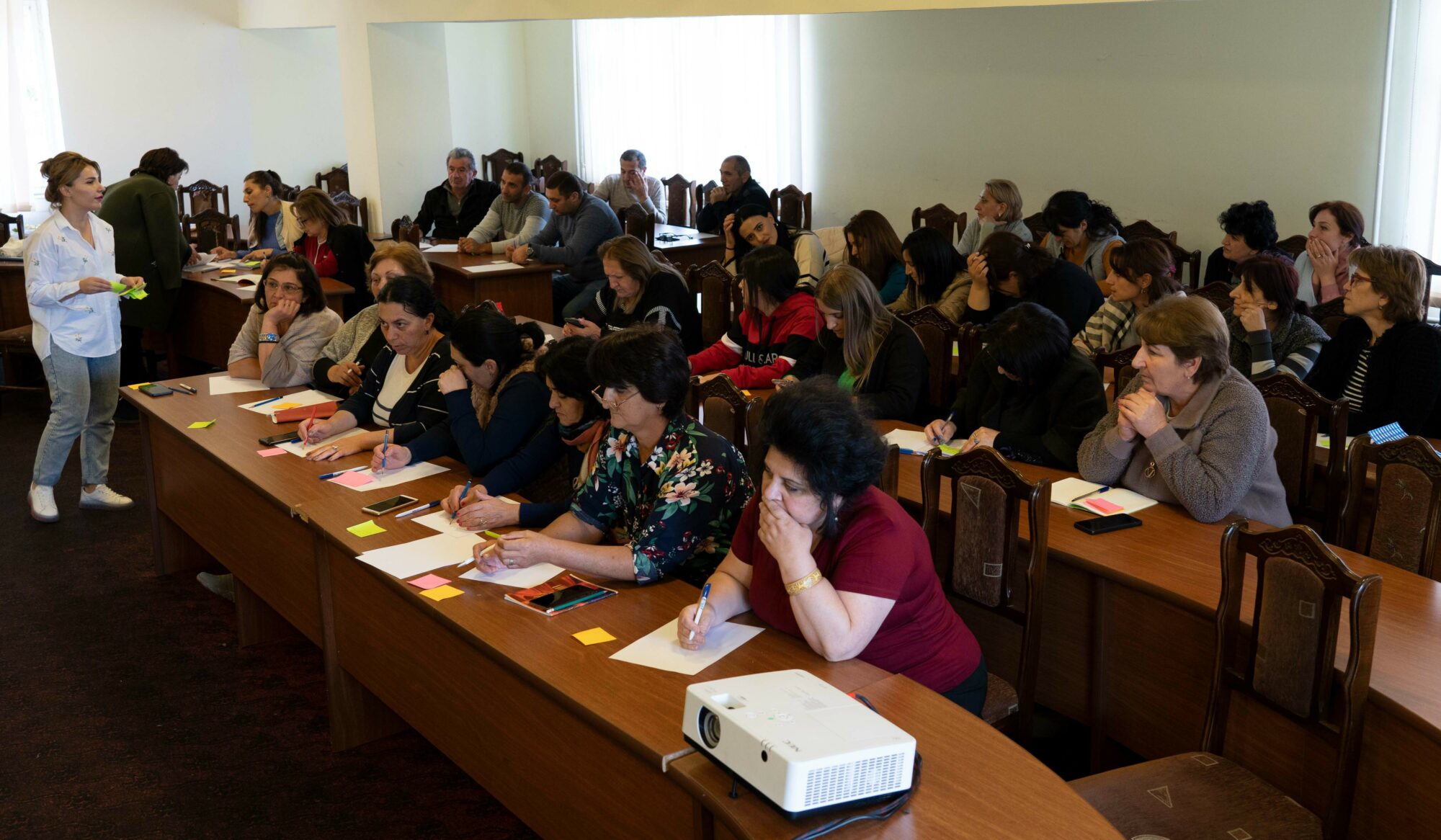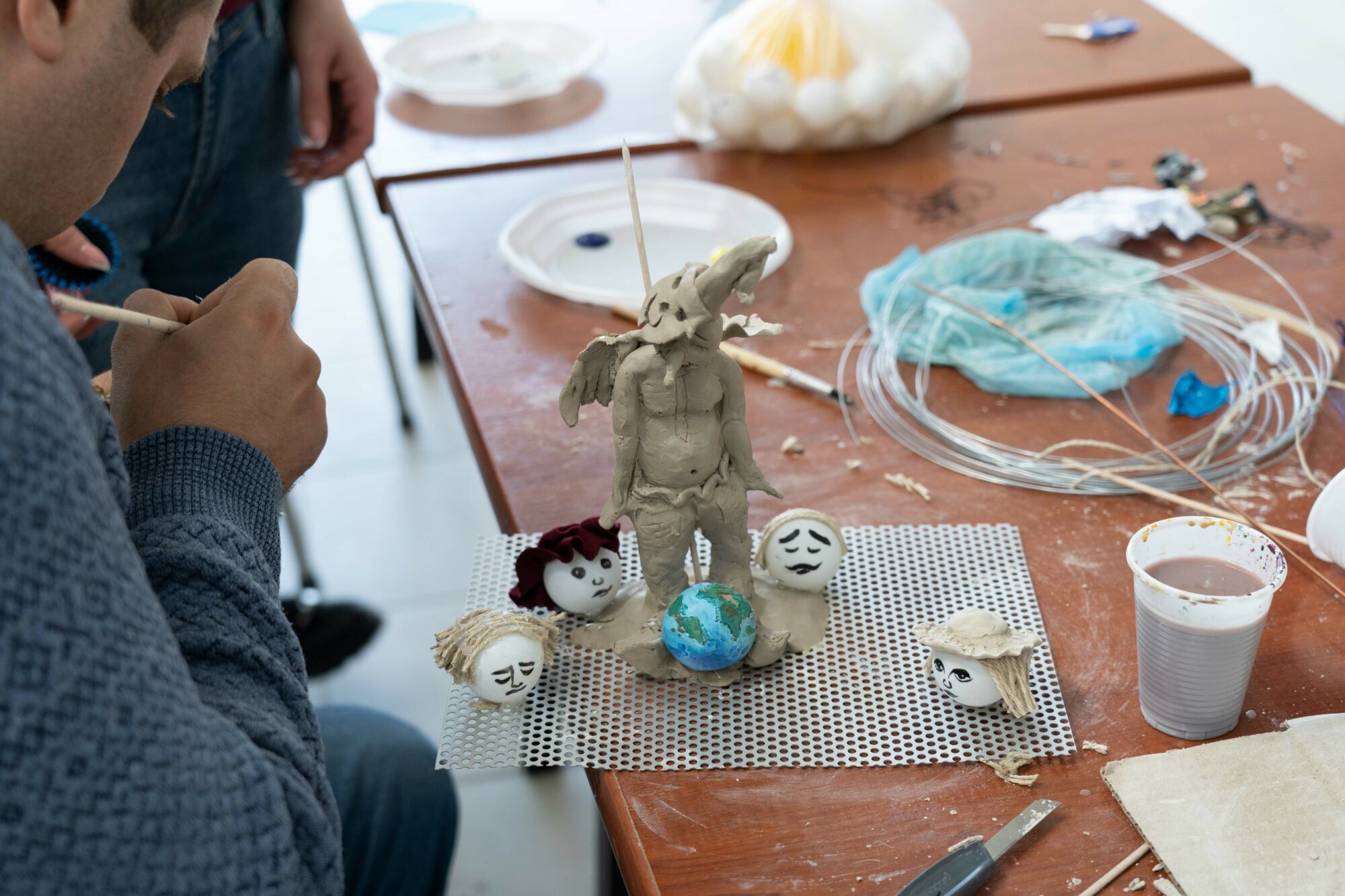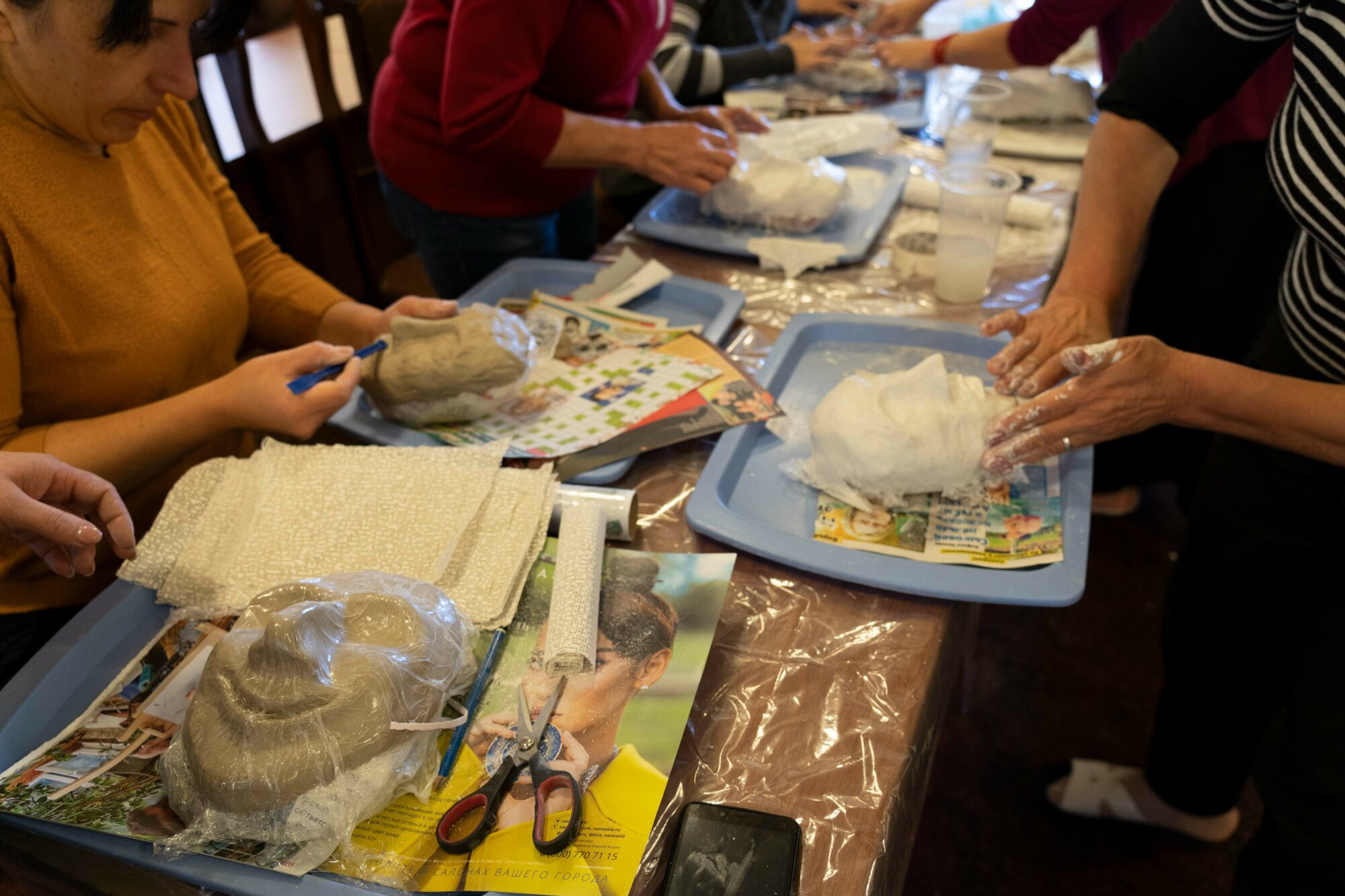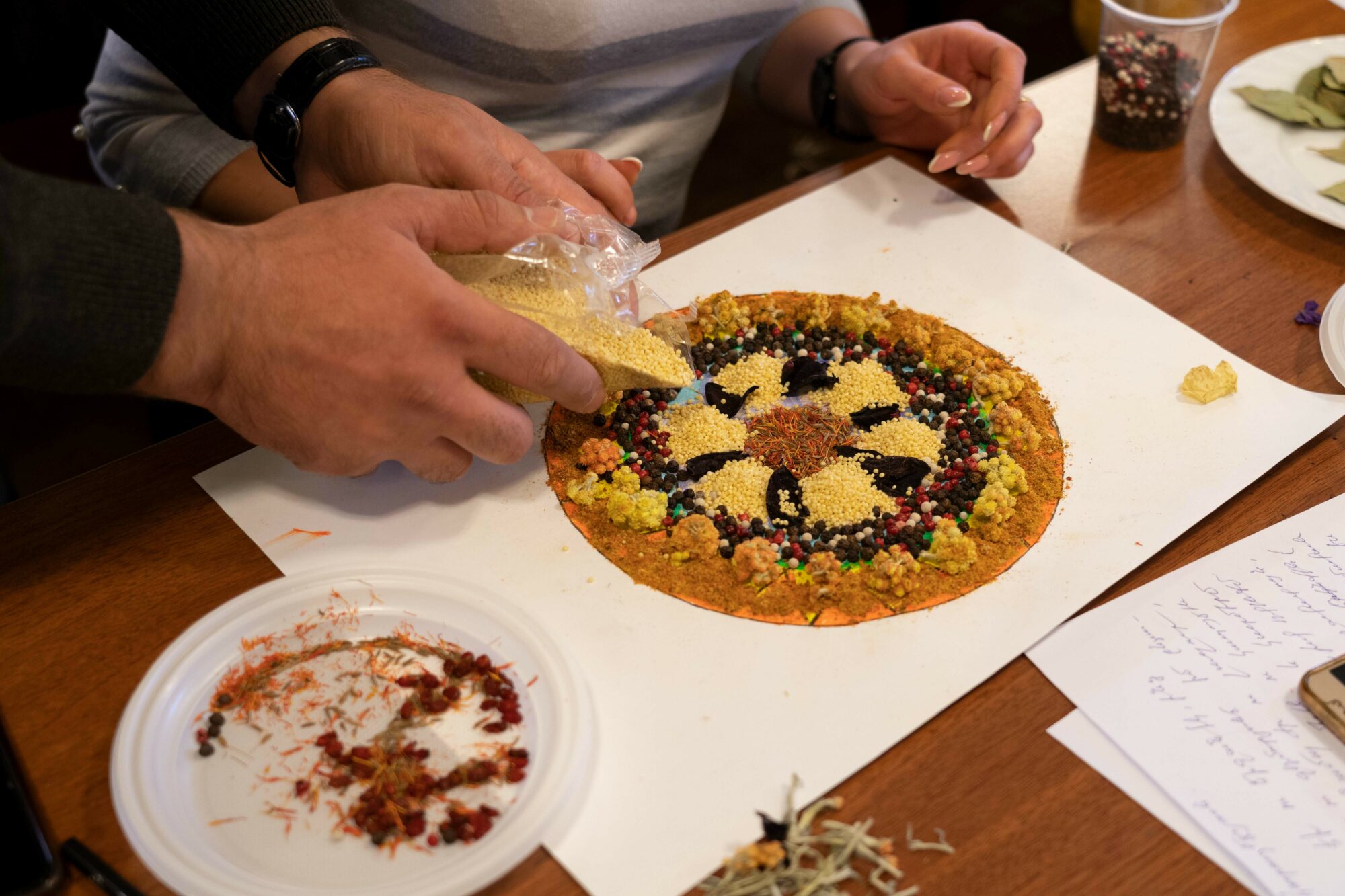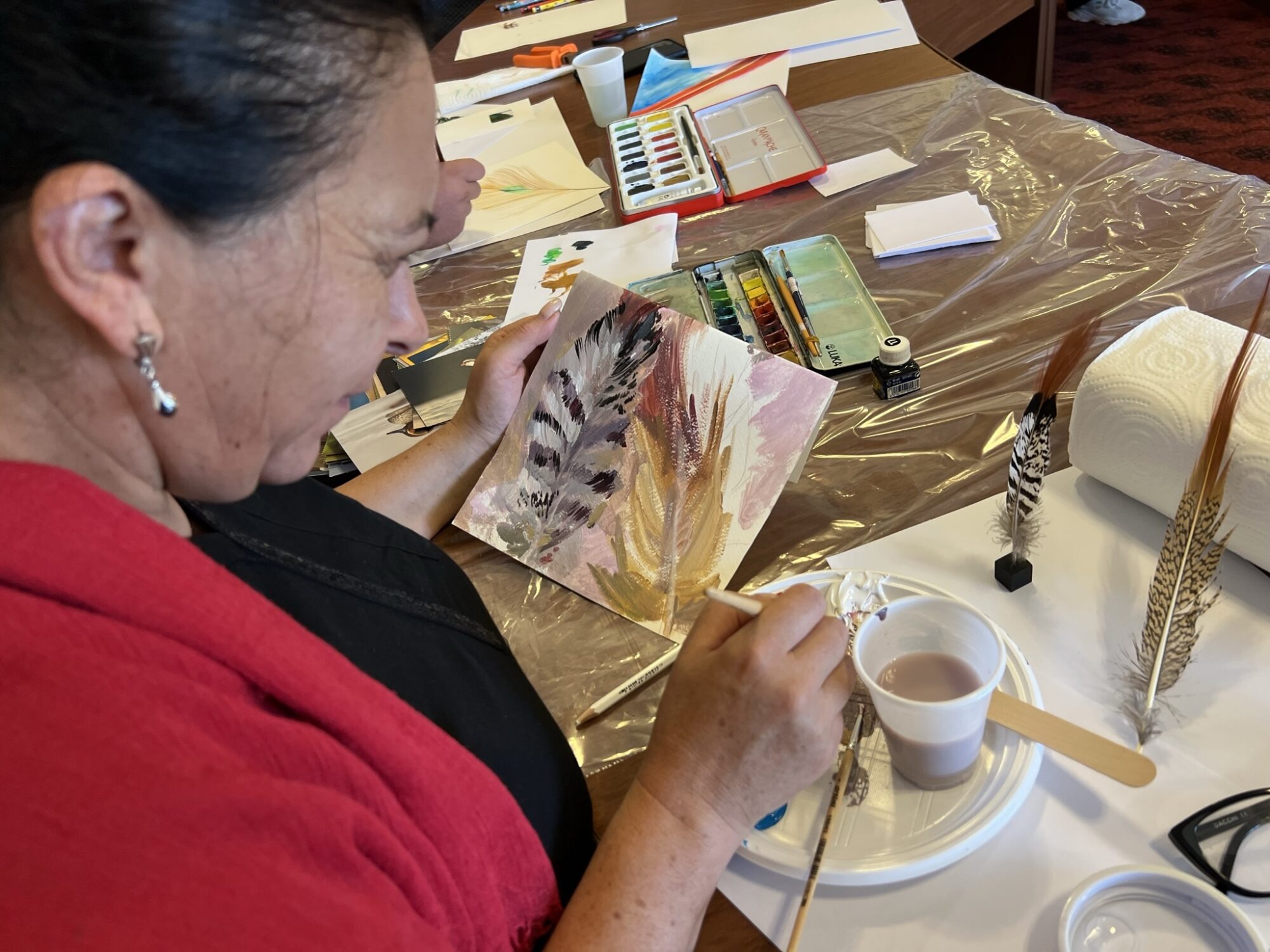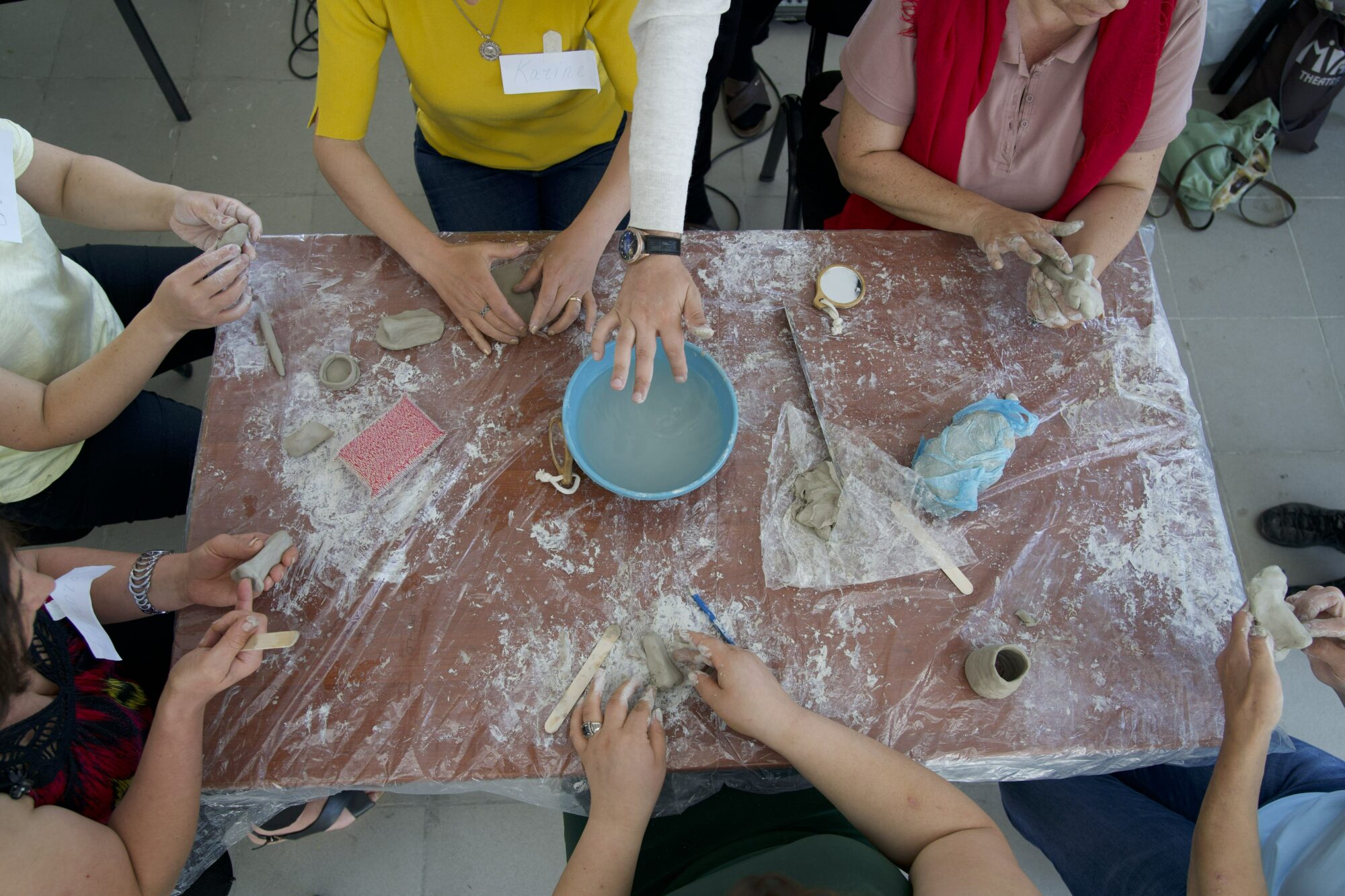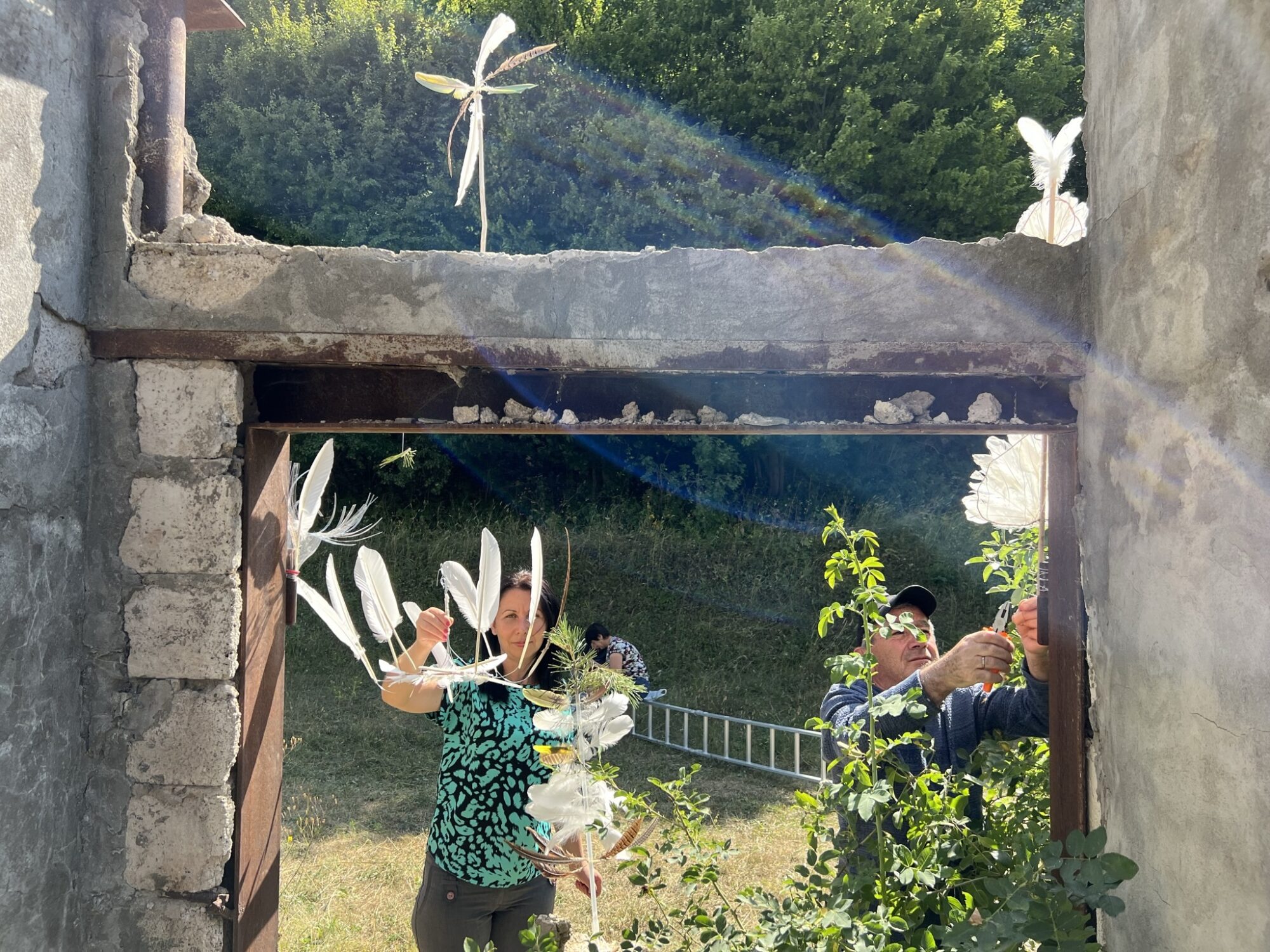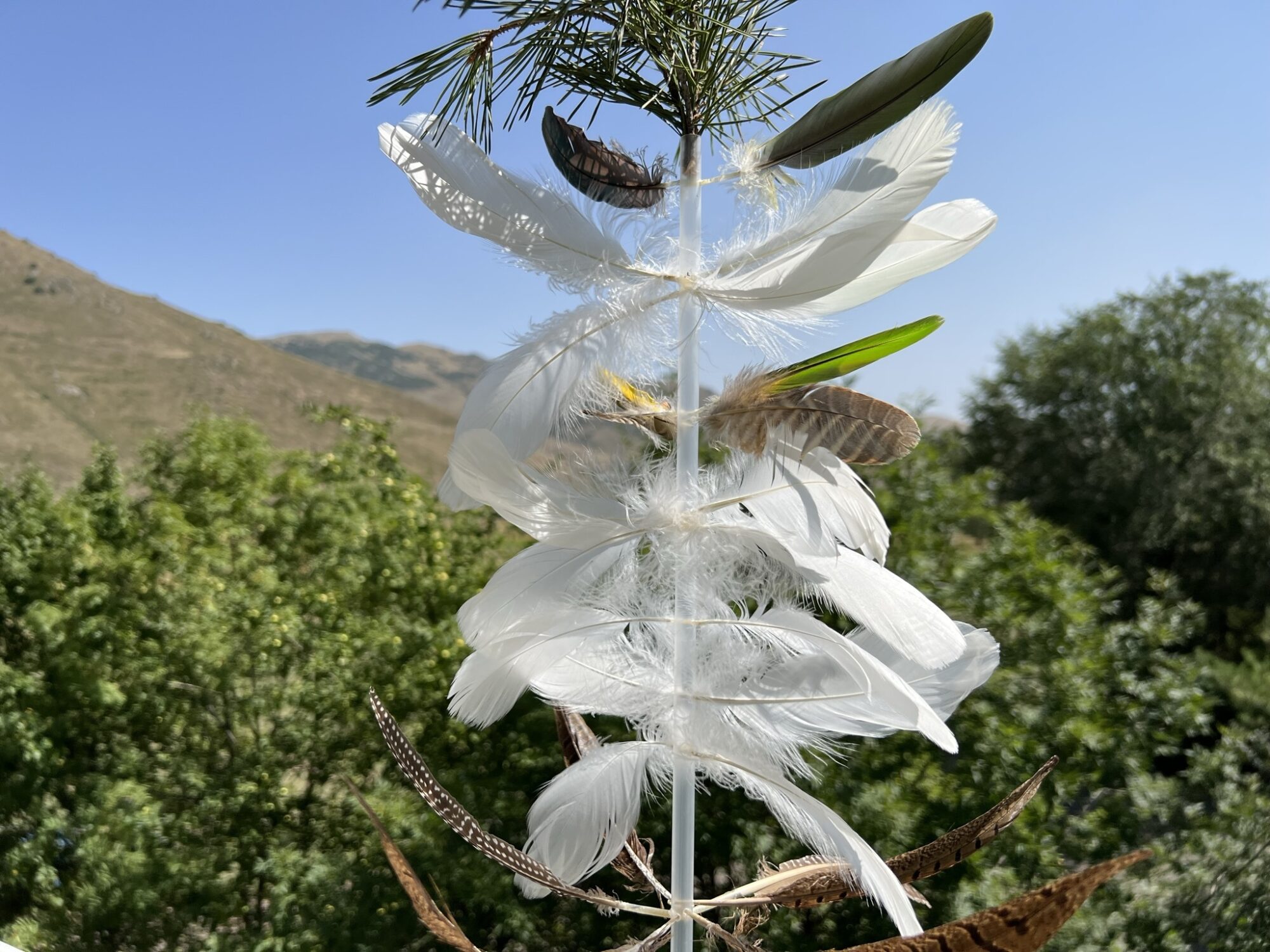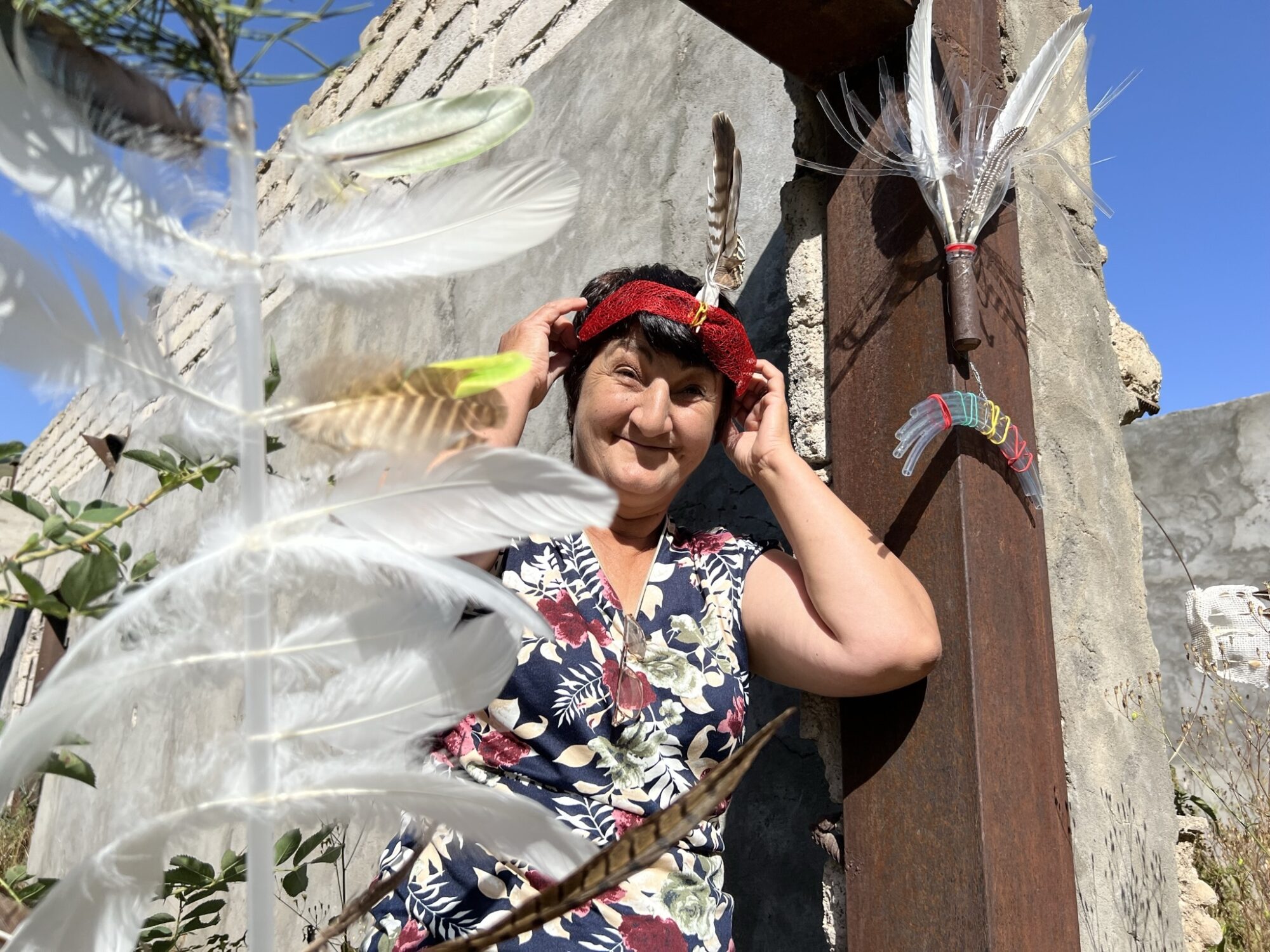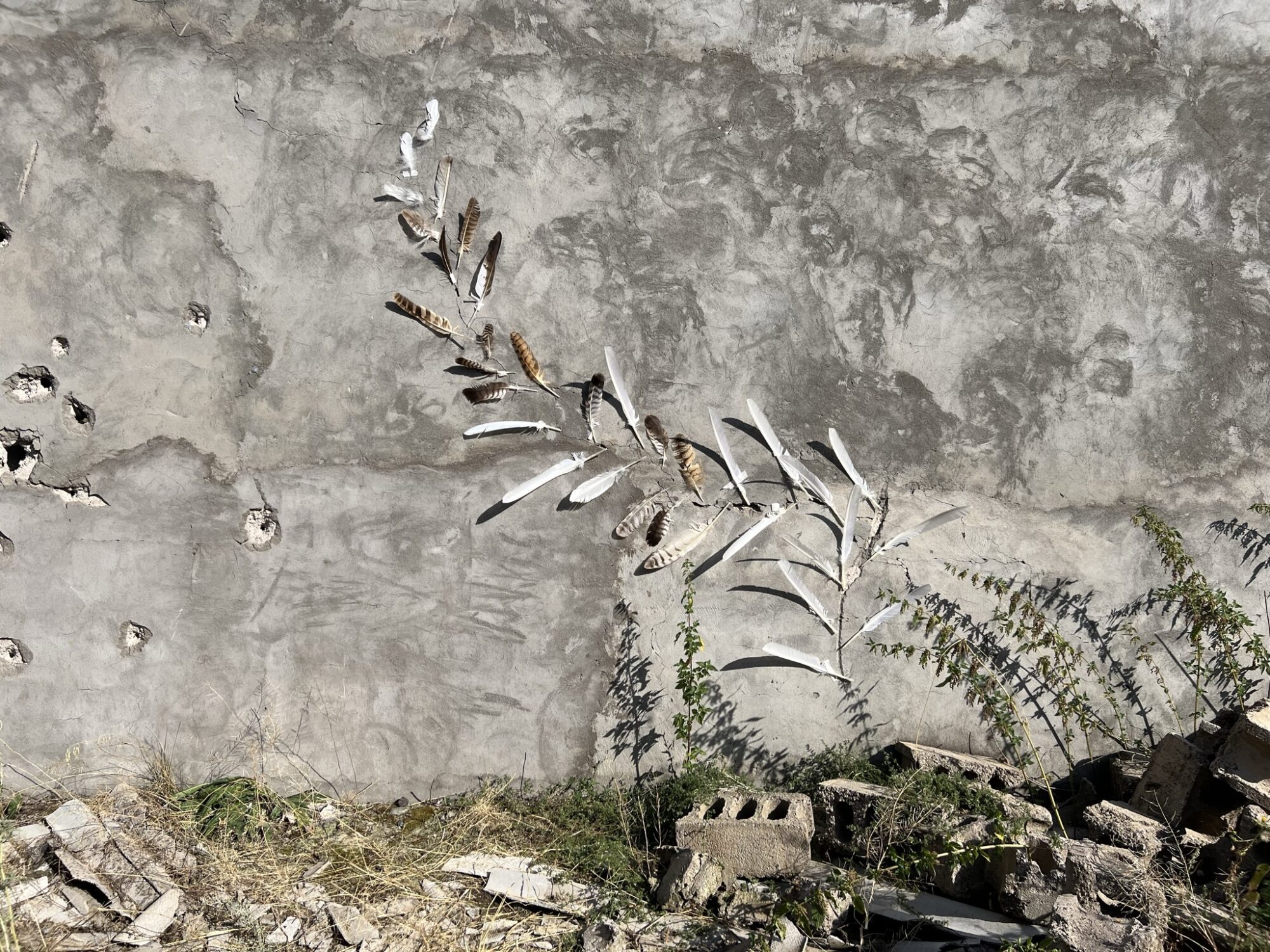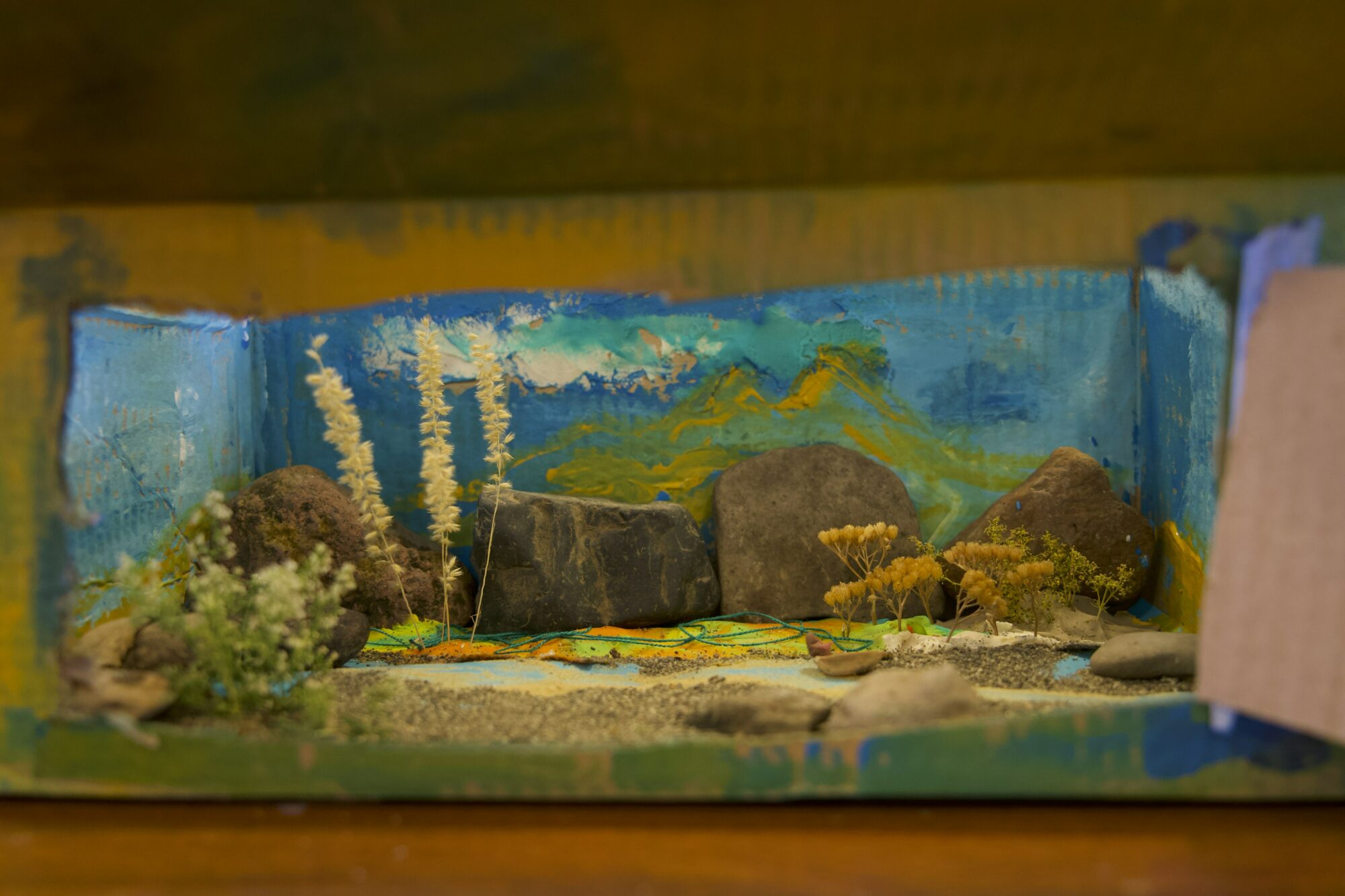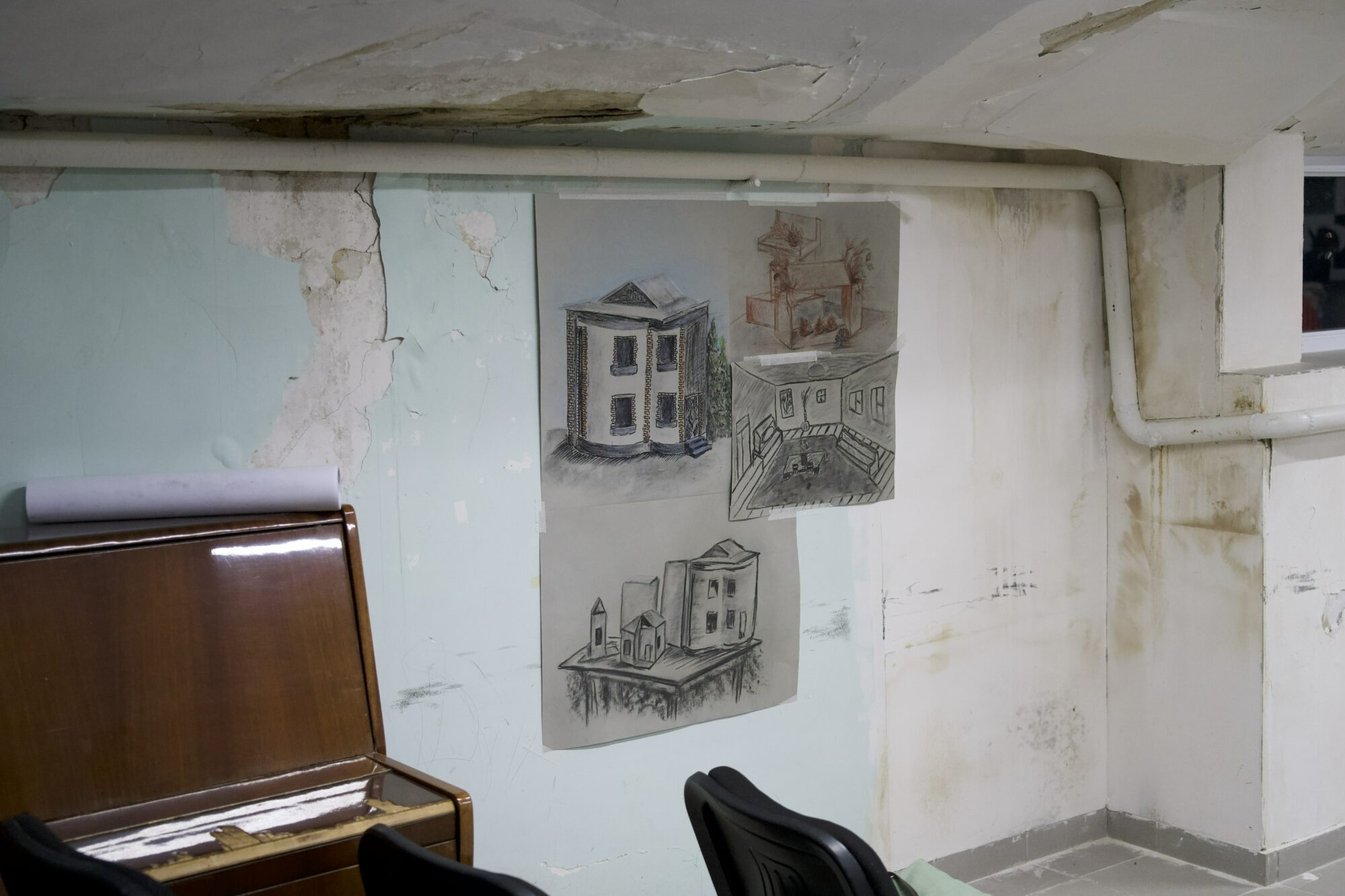Teachers’ Training
The project is based on the assumption that artistic activities provide people in conflict-affected regions with a valuable space for expressing not only their fears, but also their wishes and visions. Involved in creative work, they create a kind of shelter for their emotional needs. In regions far from the capital cities, in villages or small towns, art lessons at school are an important and often the only access to artistic activity. Art teachers are therefore of great importance, an importance that often does not correspond to the position of the subject in relation to other school subjects.
Schools in the border villages of Armenia, which are affected by the war, are confronted with a severe shortage of teachers and an aging of the teaching staff. Through great personal commitment, they try to make up for these structural difficulties. Often history or mathematics teachers are the ones who also teach art. In some small towns, there is also the tradition of afternoon schools, so-called ‚clubs‘ for art, which dates back to the Soviet era. They are highly frequented as one of the few leisure activities for children and young people, but many of their teachers were trained more than thirty years ago.
Against this backdrop, the exchange of ideas between artasfoundation and the Armenian State Pedagogical University (the country’s only institution responsible for teacher education) led us to design and offer professional training for practicing art teachers from peripheral regions of Armenia: the first such programme for teachers of art education in the country. The Pedagogical University supports it by informing the school authorities of the regions, organising the selection and training-leave of the teachers, and providing a course house in the countryside as a venue for two one-week workshops. artasfoundation is responsible for the curriculum; it invites artists and pedagogues from Armenia and Switzerland as lecturers, and pays their salaries and all other costs of the project.
In the summer and fall of 2022, the course was held for the first time. A group of accompanying experts as well as a retrospective evaluation at the schools of the course participants confirmed its success. A second edition of the course took place in 2023 and a third one in 2024.
Teachers’ Training III
The third round of the Teachers’ Training brought together 40 art and technology teachers of public schools from the peripheral cities of Armenia during the weeks of 18.–24. August and 18.–23. November 2024. The advanced training that was organised in cooperation with the Armenian State Pedagogical University (ASPU) focused on exchange about the creative methods of teaching and updating the knowledge on new methodologies. During two week-long camps the teachers were joined by four international and six local artists/art docents for conducting intensive working sessions. Like the previous rounds of the project in 2022 and 2023 the workshops took place in Aghavnadzor.
Due to already established positive reputation and popularity the demand for participation in the program remained very high with over 525 applicants. The selected 40 participants had the chance to take part in three workshops that were conducted in smaller groups of maximum 8 people. Close and intense work accompanied by the lecturers enabled them to get a better insight in each of the subjects and gain from direct contact with the tutors.
The programme was designed to enrich the classroom teaching experience and learn more about the newest trends of learning methodologies. Individual and group works were directed towards development of collages and designing textile patterns; working with clay and producing the masks; enhancing the drawing skills; processing of ideas into more complex works; working in indoor and open-air environments; using the educational games to raise motivation of students in the subject of art; application of natural, waste and secondary materials to reduce negative impacts on the environment, and efficiently using available resources.
Along the workshops participant had a chance to update their knowledge on the current state of the Armenian education system and engage in a day-long training in media literacy, learn more about the psychological methodologies of working with kids. All sessions were accompanied by two external experts from the ASPU to evaluate the process and elaborate recommendations related to the workshops.
The last day of both working modules in August and November were dedicated to exhibitions of the works produced during the sessions. After intensive interaction with local and international docents and each other participants of diverse ages and experiences established a professional network directed at further mutual support that already takes place through social media groups.
Place and Year
Aghavnadzor, 2024
Participants
Alvard Abovyan, Gohar Adamyan, Rima Ananyan, Anush Apresyan, Shushan Arevshatyan, Hasmik Avetisyan, Sonik Avetisyan, Lianna Baghdasaryan, Stella Dertsyan, Samvel Dilanchyan, Narine Dolunts, Anna Ghazaryan, Ashkhen Ghazaryan, Varsenik Ghazaryan, Hermine Grigoryan, Aghasi Hakobyan, Alvard Hambaryan, Lianna Harutynyan, Mher Harutyunyan, Nune Hayrapetyan, Voski Hovhannisyan, Marine Khachatryan, Arevik Mahlanyan, Laura Malkhasyan, Arevhat Manukyan, Marine Martoyan, Elmira Melkonyan, Anna Mosinyan, Gyulizar Movsesyan, Alisa Msryan, Ruzanna Nazaryan, Tehmine Nersisyan, Alina Poghosyan, Izabella Simonyan, Sonya Simonyan, Arusyak Tamamyan, Arus Torosyan, Armine Vardanyan, Smbat Yeganyan, Siranush Yegyan
Project Management
Shoghakat Mlke-Galstyan (artasfoundation)
Tamara Janashia (artasfoundation)
Olivia Jaques (artasfoundation)
Marianna Harutyunyan and Anahit Panosyan (ASPU)
Lecturers
Carolina Cerbaro
Diana Levonyan
Gayane Muradyan
Habib Afsar
Hayk Azatyan
Hermine Hambardzumyan
Martin Walch
Susanna Ghazaryan
Vardanush Ghazaryan
Varvara Sidorova
Invited Speakers
Aram Sargsyan
Gegham Vardanyan
Hasmik Hakobyan
Serob Khachatryan
Interpreters
Tiran Bakhchinyan
Lala Antonyan
Evaluation
Hovsep Sahakyan
Janna Khachatryan
Lems Nersisyan
Naira Mkhitaryan
Partner Organisation
Armenian State Pedagogical University (ASPU)
Financial Contribution
Caritatis Foundation
Edith Maryon Foundation
Stiftung Fürstlicher Kommerzienrat Guido Feger
Teachers’ Training II
39 art teachers from public schools in a number of peripheral cities of Armenia attended one week of advanced training in both August and November 2023. Also this round of the project Teachers’ Training was organised in cooperation with the Armenian State Pedagogical University (ASPU). Each week the group was joined by two resident and three international artists/art docents, who shared their skills and knowledge during the workshops. As in the previous course (launched in 2022) the workshops took place in Aghavnadzor. Due to the current situation in Armenia, in the November session, the residence and workshop location was shared with people seeking asylum and fleeing the Karabakh region. Especially the children among them became part of the week and enthusiastically joined in wherever they could.
The selection of the participants was made from a pool of over 400 applicants, demonstrating the very high demand for professional development training of this type, as well as the desire for exchange with local and foreign experts and the popularity of the workshops from the previous year.
Both weeks consisted of three sets of five parallel workshops conducted by two local and three international art docents. Each participant had the chance to take part in three workshops (out of fifteen) each week. Work in smaller groups of max. 8 persons made it possible for the participants to achieve more in-depth learning and benefit from intensive communication with the tutors.
The programme, which aimed at diversification of the school curriculum and inclusion of more creative methods, included individual and group work on the following topics: colours and their use for creation of geometric compositions; organising of geometric figures; abstractionism as a method; work with clay; the method of felting for creating pictures; poetic and conceptual approaches; creating masks and theatre play; mandalas, community art, art therapy, and expressive art; development of ideas from simple patterns into complex works; working in indoor and open-air environments; use of games in classroom settings for inclusion of students with learning difficulties; drawing techniques; competent use of diverse means of artistic expression; application of natural, waste and secondary materials with the aim of reducing negative impacts on the environment, etc.
The workshops in the first session were accompanied by a lecture on the current state of the Armenian education system and a day-long training in media literacy. Within this framework participants were introduced to topics such as the psychological analysis of students’ behaviour or how to deal with stressful situations and relaxation techniques. A psychologist was also invited for the second session in November and participants had the opportunity to discuss their questions with her (many of them concerned with how to work with children with special needs).
Each week was attended by two external evaluators, all of whom are experts selected by the ASPU. In the second week particularly, the evaluators became so engaged and part of the group that one of them shared her skill in making traditional dolls, which resulted in an additional evening class.
Both weeks ended with an exhibition of the pieces produced during the workshops.
For many of the participants this project was the first time they had spent a week away from their families. However, despite a broad range of professional experiences and ages they quickly formed strong bonds of expertise and friendship. In addition to the further education, central to the projects is the establishment of networks that will assist the art teachers in working together in the future.
Place and Year
Armenia, 2023
Participants
Arine Abovyan, Lernuhi Abrahamyan, Armine Antonyan, Arevik Avagyan, Knkush Baghdasaryan, Ashot Beglaryan, Arsen Galstyan, Zara Gasparyan, Haykush Gevorgyan, Mariam Gharagyozyan, Anush Ghukasyan, Tsovinar Grigoryan, Gayane Gyurjoghlyan, Armenuhi Hakobyan, Sona Hakobyan, Alita Haroyan, Armine Hovhannisyan, Ashot Khachatryan, Karen Khudoyan, Siran Kochinyan, Sona Mgrdunts, Armine Mkrtchyan, Susan Papoyan, Liana Sahakyan, Margarita Saribekyan, Tatevik Simonyan, Meline Tashchyan, Lusine Vardanyan, Armine Vardanyan, Alina Vardazaryan, Zaruhi Zakaryan
Project Management
Shoghakat Mlke-Galstyan, Yerevan/Armenia (artasfoundation)
Tamara Janashia, Tbilisi/Georgia (artasfoundation)
Olivia Jaques, Vienna/Austria (artasfoundation)
Marianna Harutyunyan & Anahit Panosyan, Yerevan/Armenia (ASPU)
Lecturers
Habib Afsar
Carolina Cerbaro
Quynh Dong
Susanna Ghazaryan
Hermine Hambardzumyan
David Khachatryan
Gayane Muradyan
Varvara Sidorova
Evaluation
Melkon Avetisyan, Gayane Eghiazaryan, Kamo Khachatryan, Aghvan Mkhitaryan
Partner Organisation
Armenian State Pedagogical University (ASPU)
Financial Contribution
Temperatio Foundation
Private Donations
Teachers’ Training I
37 teachers who teach art in schools in Armenia’s border region with Azerbaijan met in late August for the first part of the two one-week trainings in the course house in Aghavnadzor. They had been selected from almost eighty applicants. The initially somewhat tense atmosphere – for many of them it was their first week away from their family – quickly dissolved as people began to do practical artistic work in small groups under the guidance of five lecturers. Each lecturer had prepared a one-and-a-half-day programme on a different topic, and the participants were able to choose and switch between these options three times during the course. For example, there was a programme on the topic of colour and mixing colours, a programme on sculpting and drawing with a variety of materials, a classic programme on drawing techniques, one on free artistic self-expression, and one on artistic work inspired by bird feathers. After the participants had tried out everything by themselves, the application of the working methods in the classroom was discussed. A lecture on curriculum reform in Armenia and a full day on teaching media literacy complemented the practice-centred work. The course week ended with an exhibition of all the works created. Everyone was amazed and also a little proud of what had been achieved here!
The second week of the training was scheduled for mid-October, but in September the war with Azerbaijan flared up again. Would the participants now be able to devote themselves to art for a week? In the end, 36 of 37 participants decided to come (‚We want to live as normal a life as possible, even in this difficult situation.‘) and we were able to continue the course as planned: with new content (graphic design, making fanzines, designing masks, working with mandalas) and also with artistic work in nature. It was always important to use working materials that are also available to teachers at their schools. The theoretical part of the course dealt with curricular issues, as well as with possibilities of psychological support for young people in the classroom.
In the course of the week, more and more works were created. Supplemented with works that had been produced as ‚homework‘ since the first course, they formed the rich final exhibition, an adequate setting for the presentation of diplomas to all graduates of the course.
Place and Year
Armenien, 2022
Participants
Gayane Ananyan, Margarit Ananyan, Margarit Avetisyan, Melanya Avetisyan, Nairi Balabekyan, Nvard Chilingaryan, Eleonora Dallakyan, Azganush Danielyan, Arusyak Grigoryan, Narine Grigoryan, Karine Gzghoyan, Norayr Hambard, Ruzan Israyelyan, Tehmina Karapetyan, Gayane Karapetyan, Margo Manasyan, Gohar Maralchyan, Gevorg Matinyan, Artur Melkonyan, Gayane Navasardyan, Azniv Nersisyan, Pavlik Nersisyan, Nazik Paranyan, Ruzan Petrosyan, Tamara Poghosyan, Anahit Rustamyan, Haykush Sargsyan, Susambar Sargsyan, Naira Sargsyan, Parandzem Shahinyan, Milena Siradzeghyan, Meline Tamamyan, Nune Tamrazyan, Aida Vardanyan, Novik Yeritsyan, Arpine Zakharyan
Project Management
Shoghakat Mlke-Galstyan, Yerevan
Dagmar Reichert (artasfoundation)
Julien Fehlmann (artasfoundation)
Marianna Harutyunyan and Anahit Panosyan, ASPU Yerevan
Lecturers
Habib Ahmed
Martin Brun
Vardanush Ghazaryan
Cécile Hummel
Gor Shahbazyan
Varvara Sidorova
Andrea Wolfensberger
Interpreters
Taguhi Adamyan, Samvel Aslanyan, Stella Loretsyan, Shushan Minasarian, Anahit Panosyan, Viktorya Varosyan
Evaluation
Janna Khachatryan, Artur Martirosyan, Naira Mkhitaryan, Lems Nersisyan
Partner Organisation
Armenian State Pedagogical University (ASPU)
Financial Contribution
Private Donations
